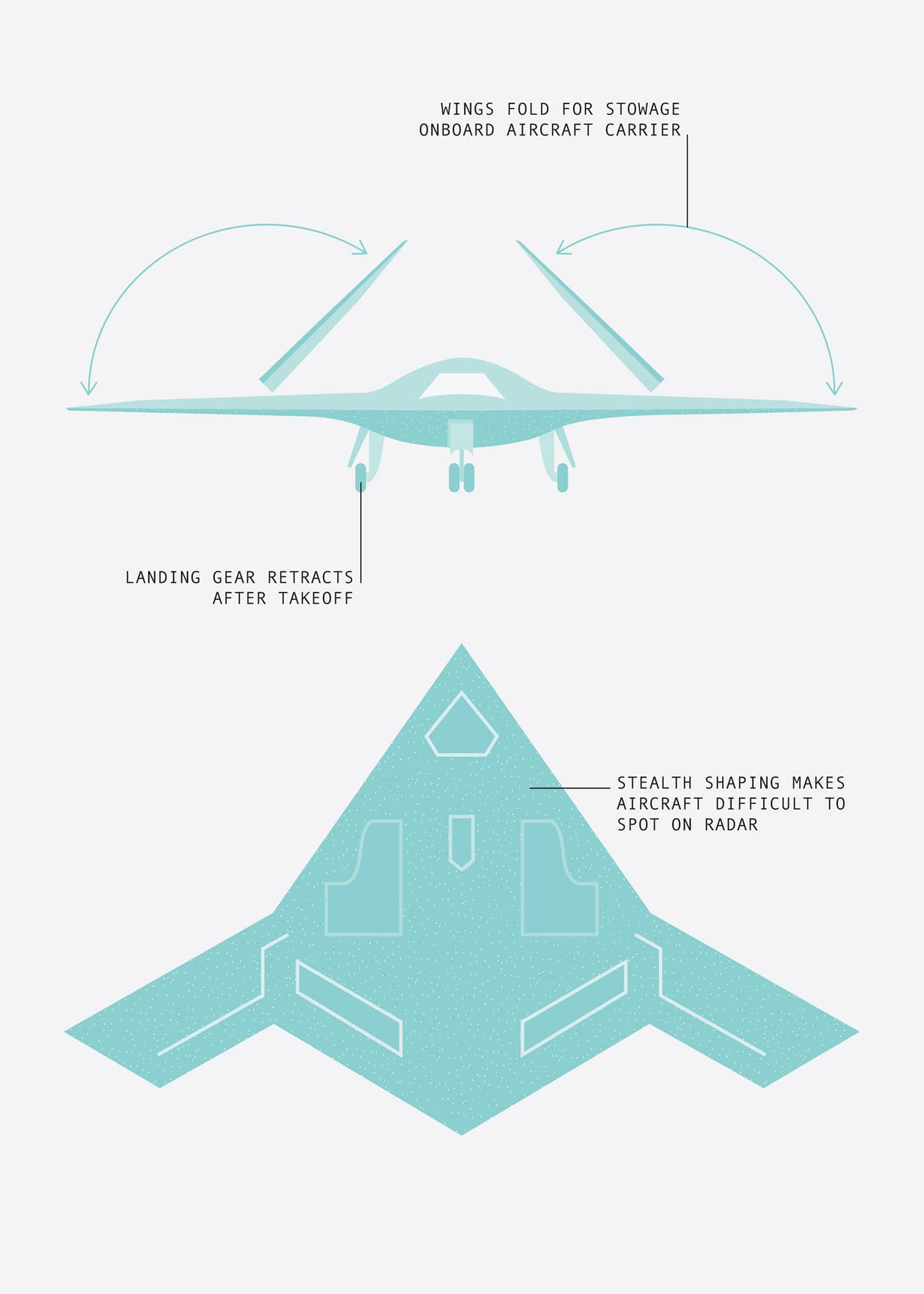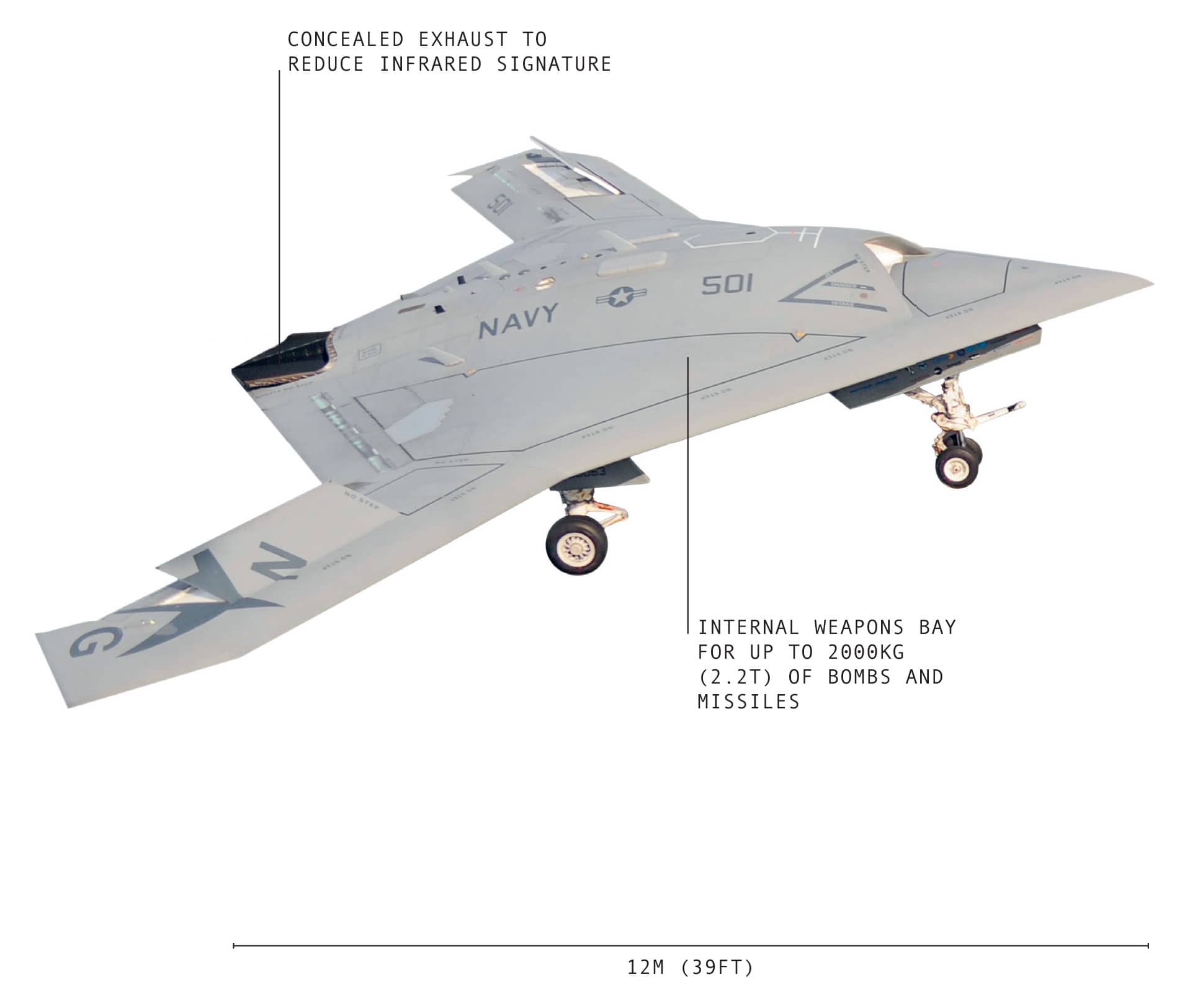ROBOTS
AT WAR

ROBOTS AT WAR
Perhaps the first military robots were eighteen-century fireships, unmanned vessels that crashed into enemy ships, bridges or fortifications to destroy them. The British called them ‘machine-vessels’ after the mechanical timer that was used to set off the fuse, and the Italians maccina infernale or ‘machine from hell’.
Remote-controlled boats have been around since the 1890s, but navies have largely resisted using them. That may change with the Sea Hunter, an autonomous vessel designed to track submarines. Meanwhile robot submarines themselves are on the brink of a new era. Small, short-ranged, unmanned underwater vehicles have been around since the 1950s, but Echo Voyager is the prototype of a much larger vessel able to operate on its own for months on end.
The first military drones were arguably the balloons used to drop bombs on Venice during the Austrian siege in 1849. Franz von Uchatius, best known as the inventor of an early motion-picture projector, rigged small hot-air balloons to release bombs when a command signal was sent down a long copper wire. They were not successful; the technology was not up to the task.
Drones reappeared in the First World War, in the form of radio-controlled biplanes. These ‘aerial torpedoes’ carried an explosive charge to destroy enemy airships or ground positions, but neither the British Sopwith AT nor the American Kettering Bug was considered reliable enough to be used in action.
Drones have never been popular with air forces, but the Predator drone proved so effective in gathering intelligence during the conflicts in former Yugoslavia in the 1990s, that it was no longer possible to resist pressure from the intelligence community. The US Air Force reluctantly acquired a fleet of Predators. These started to carry their own missiles in 2001, after a series of incidents in which ‘high value targets’, including Osama bin Laden, were spotted, but air strikes could not be called in fast enough.
The Predator has since been superseded by the bigger and more powerful Predator B, better known as the Reaper. In military terms, it is a light reconnaissance aircraft with some weapons; the X-47B under development is a more serious combat aircraft. Meanwhile much smaller attack drones, like the portable Switchblade, are becoming important for tactical operations.
Remote-controlled ground vehicles have also existed since before the Second World War, but they have been largely limited to niche roles, such as bomb disposal, where machines like the PackBot 510 are essential. The Minitaur is a novel legged design offering greater mobility, which may prove valuable for urban reconnaissance. The XOS-2 is a more exotic development: a robotic exoskeleton giving its wearer enhanced strength and endurance. It will initially be used for logistics, but with the ultimate goal of a suit of powered armour that turns its wearer into a walking tank. The Covert Robot is equally remarkable, being a stealthy robot used to infiltrate enemy positions and move around silently without being spotted.
The only armed ground robots in service are South Korea’s SGR-1A sentry robots. Russia experimented with remote-controlled ‘teletanks’ in the 1930s, and is pushing forward with a slew of armed ground robots, including Kalashnikov’s ‘Comrade in Arms’. The United States is more cautious, and armed vehicles like the Ripsaw are many years from service.
There are campaigns to actively prevent the development of ‘killer robots,’ not remote-controlled machines like the Reaper but autonomous robots able to find and attack targets without human oversight. The US military insists that they will always maintain a ‘man in the loop’, a human operator who needs to pull a trigger for weapons to be released.
Even if autonomous machines are banned, military robots are proliferating fast. Robots may replace soldiers on the front line, so the only humans involved may be commanders and drone operators on either side– and the civilians in the middle.
PACKBOT
Height |
17.8cm (7in) |
Weight |
11kg (24lb) |
Year |
2002 |
Construction material |
Steel |
Main processor |
Proprietary processors |
Power source |
Lithium ion battery |
Bomb disposal may be one of the most dangerous jobs in the world. Any detonation is likely to be fatal, and improvised explosive devices (IEDs) can be incredibly tricky to disarm. Bomb-disposal robots save lives by widening the distance between the explosives and those trying to defuse them.
The first bomb-disposal robot was the 1972 Wheelbarrow, invented by Peter Miller, a former British Army officer. Designed to help deal with increasing numbers of car bombs in Northern Ireland at the time, Wheelbarrow was a simple remote-controlled tracked vehicle, based on a wheelbarrow with an electric motor. Its specific task was to attach a hook to a car bomb so it could then be towed away to a safer location. Since then, bomb-disposal robots have become increasingly sophisticated, gaining video cameras, robotic arms, disruptors and other accessories.
In 2002, the same year that they launched Roomba (see here), iRobot® also launched a bomb-disposal machine – PackBot – which quickly proved its value in Afghanistan and Iraq. More than six thousand units have been delivered to date – sufficient to see the operation develop into a separate business, Endeavour Robotics®. Troops get quite attached to these mechanical heroes. One group of operators requested to have their ‘fallen’ comrade repaired rather than replaced with a new machine.
The current flagship model is the PackBot 510, but there are larger and smaller machines for different uses. Some can be tossed through the open window of buildings deemed too dangerous for humans to enter; others are massive machines for breaking into truck bombs. All are exceptionally rugged, to enable them to cope with the impacts and environmental extremes of military services. PackBot’s developers discovered that this had to be built in from the start, and that it was impossible simply to strengthen an existing design. In order to reach a bomb, a robot may need to climb curbs and stairs and traverse rubble.
PackBot gets its name from the fact that it is packable; weighing just 11kg (24lb), it can be carried by one person and set up in two minutes. Mobile ‘flippers’ act as extensions to its tracks, enabling it to cross rough terrain and scale stairs, despite its small size. It can cross streams or ponds and even operate down to 1m (3.2ft) underwater. Being only 50cm (20in) wide, it fits easily through internal doorways.
PackBot is radio controlled and has sensors to give its operator the best possible view. These include multiple, high-resolution cameras for driving, a turret-mounted zoom camera, and thermal imaging. It has lights, both visible and infrared, and microphones.
Eight payload bays accommodate a variety of optional extras. These include a robotic arm known as a ‘manipulator’ with a camera and grippers to grab and move objects that at its full extension of over 1.8m (5.9ft) can lift 5kg (11lb). One of the commonest tools is a ‘disruptor’, a small, directional explosive device that destroys a bomb without setting it off.
The robot also has cable cutters. Real-life bomb disposal is never a matter of ‘cut the red wire’, but many bombs are detonated via a command cable. Cutting this is often the easiest way of removing the danger. PackBot can find and dig up buried objects with a probe fitted to its hull, as many IEDs are concealed under earth or sand.
The original PackBots were entirely remote-controlled and had no intelligence, but the machines are gradually growing smarter. The current version uses its arm to right itself if it overturns. If it loses radio communication, it will backtrack along its path automatically until its operator regains control. Future versions will be able to explore buildings on their own – a military version of domestic Roomba, if you like.
Police forces and firefighters also employ PackBots – not for suspected bombs, but for other potential hazards, involving chemicals or radioactive materials. One thing you can be sure of: every time PackBot goes into action, it is keeping a human well out of harm’s way.
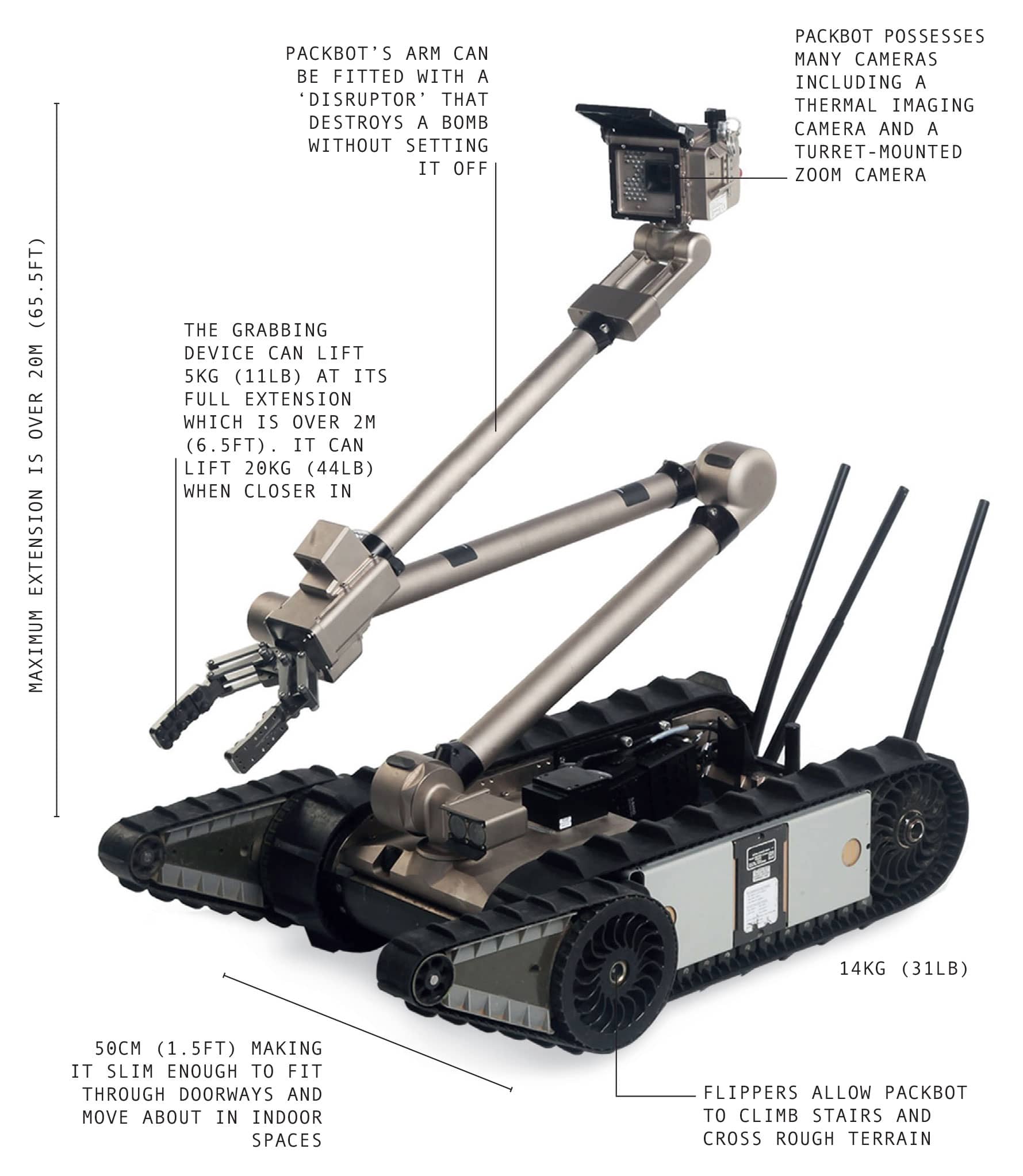
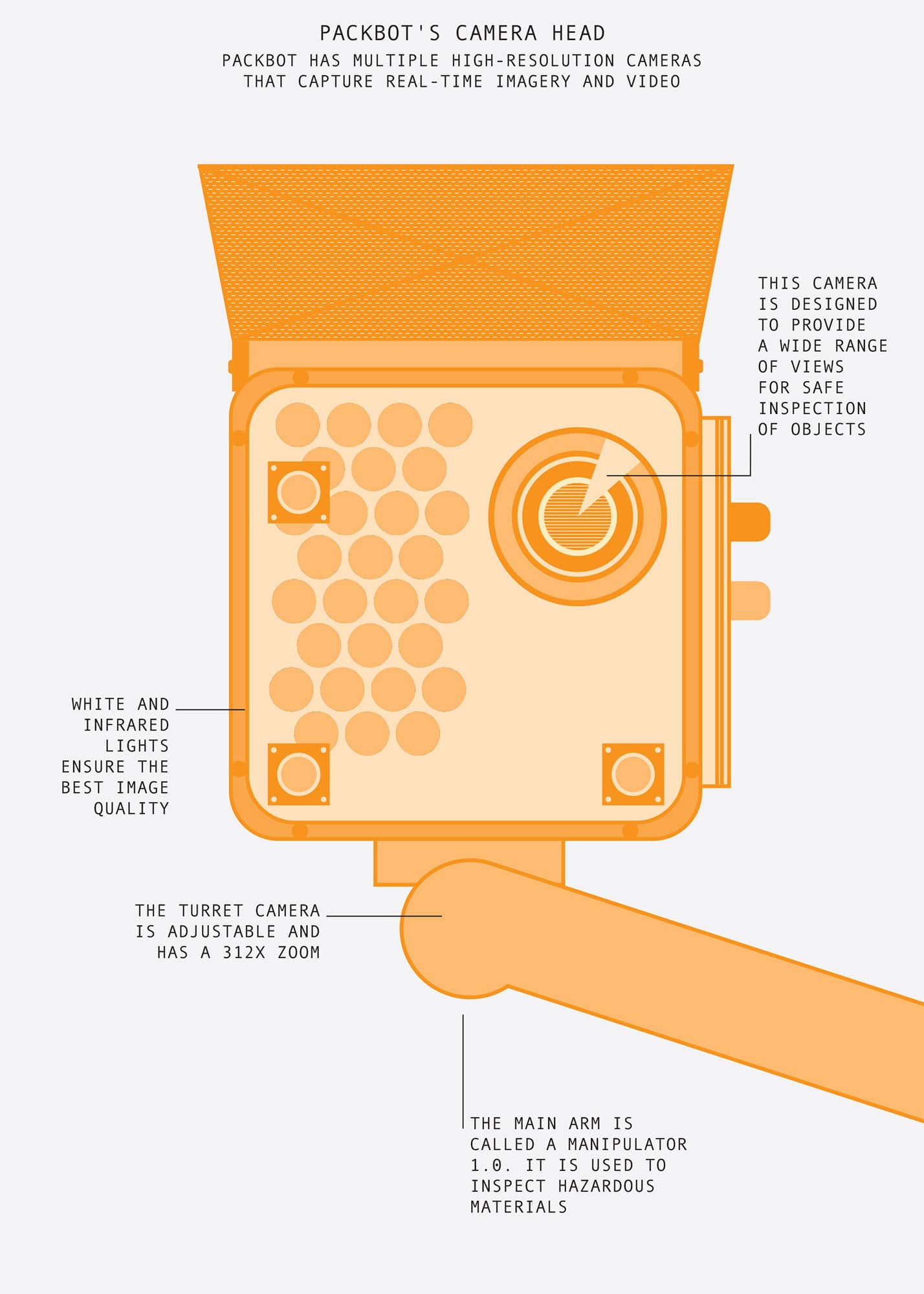
XOS-2 EXOSKELETON
Height |
2m (6.6ft) |
Weight |
95kg (209lb) |
Year |
2010 |
Construction material |
Steel |
Main processor |
Unspecified |
Power source |
External power |
Ever since sci-fi ‘dean’ Robert Heinlein wroteStarshi‑p Troopers in 1959, the powered exoskeleton has been a science-fiction dream for the military. Effectively it is a wearable robot in the form of the a suit. Memorably depicted as the ‘power loader’ that Sigourney Weaver’s character used in the movie Aliens, Marvel’s Iron Man also has a more advanced version. Stepping into an exoskeleton turns the mere mortal into a superhero able to lift heavy objects or smash through walls.
The XOS-2 (short for eXOSkeleton) developed by Sarcos Robotics™ is the real world’s most advanced version revealed to date. The American developer unveiled XOS-2 in 2010, having developed an original model, XOS, in 2000 as the Wearable Energetically Autonomous Robot (WEAR). The XOS-2 was geared towards the military, specifically designed for the logistics mission – that is, loading and unloading cargo such as ammunition. Even today much of this work is carried out manually, and a soldier may shift as much as 7,000kg (15,430lb) per day by hand. XOS could triple this, effectively meaning that one soldier could do the work of three.
The XOS-2 weighs 95kg (209lb) and has elaborate hydraulics to magnify the operator’s strength to lift weights of 90kg (198lb) with ease – the operator only needs to exert 1kg (2.2lb) of force to lift a 17kg (37lb) weight. Increased strength means greater endurance; the operator can shift heavy loads all day without getting tired. XOS-2 does not have hands, but mechanical pincers, known as ‘effectors’ for gripping and lifting objects. Because XOS-2 also amplifies leg strength, the operator can walk, run, or even stand on one leg, despite the weight of the suit. Multiple sensors in each joint make the XOS-2 responsive enough for climbing stairs and kicking a football, and the operator can recover their balance if they stumble.
XOS-2 is not fully mobile. The onboard power source is an internal combustion engine with fuel for half an hour, but it also needs an external hydraulic power source, and a flexible cable provides the high pressure for the powerful hydraulics. Most impressive is the intuitive behaviour. Operators get the hang of the exoskeleton within a few hours compared to the three to five days’ training needed to drive a forklift truck.
After successful demonstrations in 2010, XOS-2 was shelved. Sarcos are currently working on a more sophisticated exoskeleton known as the Guardian XO. No specifications have been released, but a key difference is that the XO will be completely self-contained and run on battery power for six to eight hours. Ben Wolff, CEO of Sarcos, says that the dramatic improvement is not a matter of using better batteries, but making the suit more efficient. The XO consumes about one-tenth as much power as XOS-2, and this makes battery power feasible. In an echo of Leonardo da Vinci’s work on humanoid robots, Wolff says that nature provided Sarcos with some of the most efficient solutions. The company has a history of making prosthetics, and biomechanics is one of its key areas of expertise.
The Guardian XO will launch in 2019. More compact, and operating in a smaller space than a forklift or crane, it should be a highly efficient load mover. Several XO operators will be able to work in a space normally occupied by a crane, and can move the exoskeletons around easily, as needed. The exoskeleton is also more intuitive and potentially safer than a forklift, and Wolff believes that it will be highly competitive in areas such as manufacturing, construction, logistics, warehousing and shipbuilding.
The Guardian XO will have no trouble meeting the military requirement for shifting ammunition, and the technology might even form the basis for actual powered armour, but will its launch come too late?. Combat robots are also developing rapidly, and by the time a real-life Iron Man suit is ready, it may already be obsolete.
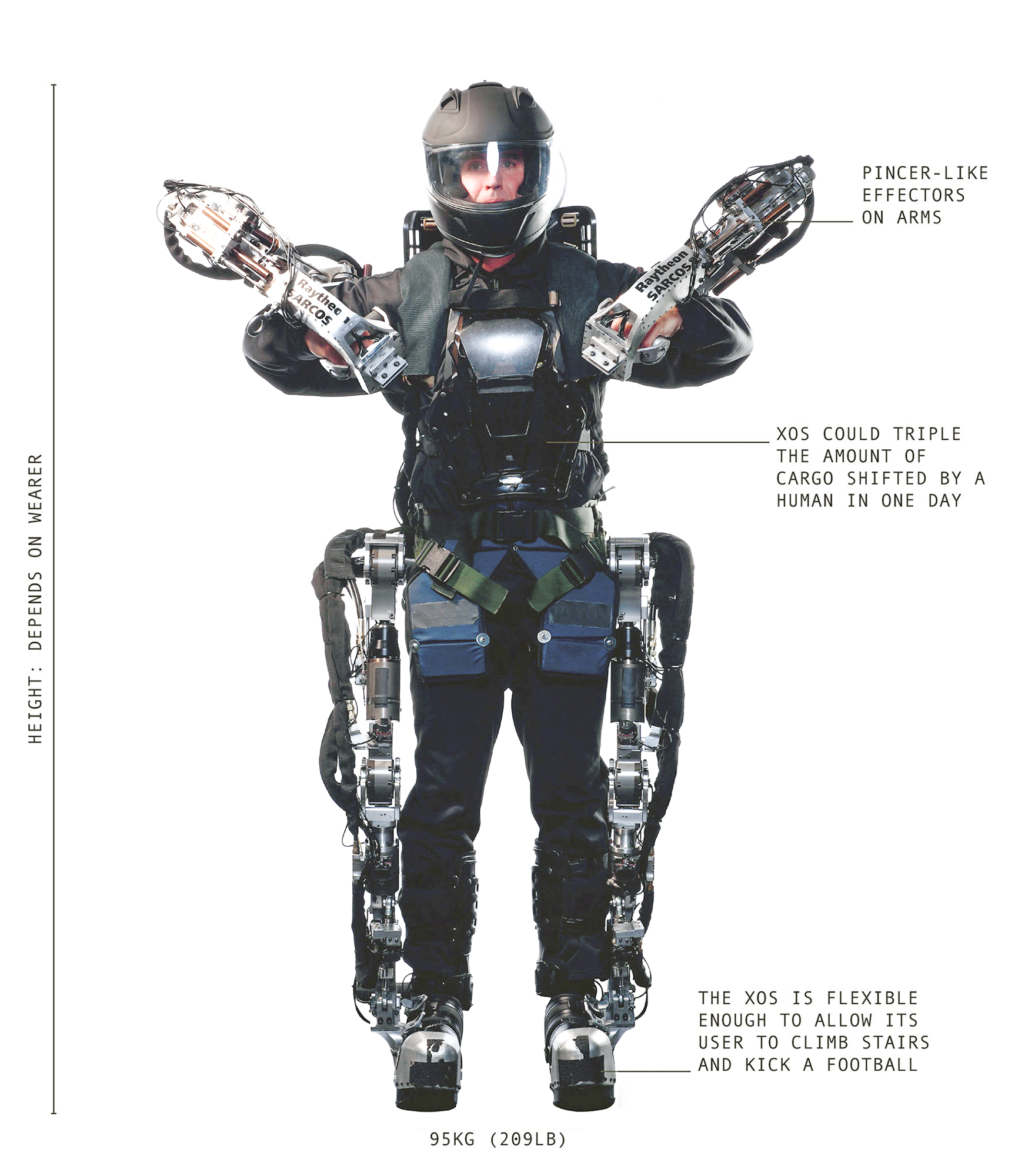

MQ-9 REAPER®
Height |
3.81m (12.5ft) |
Weight |
4.76mt (5.25t) |
Year |
2002 |
Construction material |
Lightweight composites |
Main processor |
Proprietary processors |
Power source |
Honeywell TPE331-10 turboprop, 900HP (671kW) |
The General Atomics MQ-9 Reaper is at the sharp end of drone warfare, the unmanned aircraft used by the United States and British military to carry out strikes against insurgents and terrorists across the globe.
In military aviation terms, the Reaper may seem an unimpressive aircraft. Its wingspan of 20m (65.6ft) is twice that of Lockheeds’s F-35, the latest manned combat jet, but its takeoff weight is one-sixth as much. Reaper’s top speed is 300mph (480kmh) compared to the F-35’s 1,200mph (1,930kmh) and the drone has none of F-35’s dogfighting agility. You will not see Reapers performing aerobatics at an air show, and they would be easy prey for modern radar-guided air defences. But there is one big advantage to the Reaper’s light weight and broad wingspan: endurance. Like a glider, it can stay aloft with minimal effort, remaining airborne for twenty-seven hours at a stretch. It is an untiring eye in the sky for prolonged and detailed observation.
Developed from General Atomics earlier Predator, the Reaper is a remote-controlled aircraft rather than an autonomous one. It usually takes off from an air base a few hundred miles from the scene of the action and is guided by an operator on the ground. Once airborne, control passes over to a remote operating station, usually Creech Air Force Base in Nevada, which can control Reapers anywhere in the world thanks to its internal satellite communications dish. A two-person crew flies the Reaper: a pilot is responsible for flying the drone, while a payload operator handles the sensors and weapons. Shifts change every few hours, so several crews fly the same aircraft during any one mission.
A Reaper typically circles an area at 3,000m (10,000ft) – high enough that it cannot be heard and is unlikely to be spotted from the ground, but close enough for it to get a clear view.
The Reaper’s main sensors are housed in a ball mounting, which rotates to any angle to keep a target always in view, whichever way the Reaper turns. This has thermal imaging and visible-light cameras with a 200x zoom on them, equivalent to a 12,000mm (39.4ft) telephoto lens on a 35mm camera. Some say it is able to read a licence plate from operating altitude. A Reaper may follow a vehicle or an individual, or observe a building or a village, carrying out a ‘pattern of life’ study and watching the comings and goings of various occupants. A Reaper may also carry radar and sensors to detect, locate and tap into radio signals below including mobile phones. Strikes may also be guided by radio trackers planted in a target’s car or house by local agents.
The Reaper carries a mix of 500lb (225kg) bombs and Hellfire missiles, both laser guided. A laser designator in the sensor ball highlights the target, and the missile strikes where the laser is pointed. ‘Super-ripple’ firing means the Reaper’s fourteen Hellfire missiles can be fired with just one-third of a second between missiles. The missiles are highly accurate, which raises two issues for the operators. The first is that they must be certain of their target; and the second is that Hellfire’s 10kg (22lb) high-explosive warhead will kill or injure, not just the target, but anyone in the immediate vicinity.
Unmanned aircraft like the Reaper give intelligence agencies new options. They can enter areas in which it is too dangerous or too controversial to fly a manned plane, because there is no risk of losing a pilot and, if lost, drones can be denied. This means that intelligence agencies can track, locate and attack networks of terrorists in places that they could not otherwise reach, with little political risk.
Drones like the Reaper are not used for fighting conventional wars, but have opened up a new style of unconventional warfare. They have been highly effective at targeting terrorist leadership and have shown that there is nowhere to hide from drones. But is this enough to counter the fact that many people are uncomfortable over the civilian casualties and lack of accountability in drone warfare?
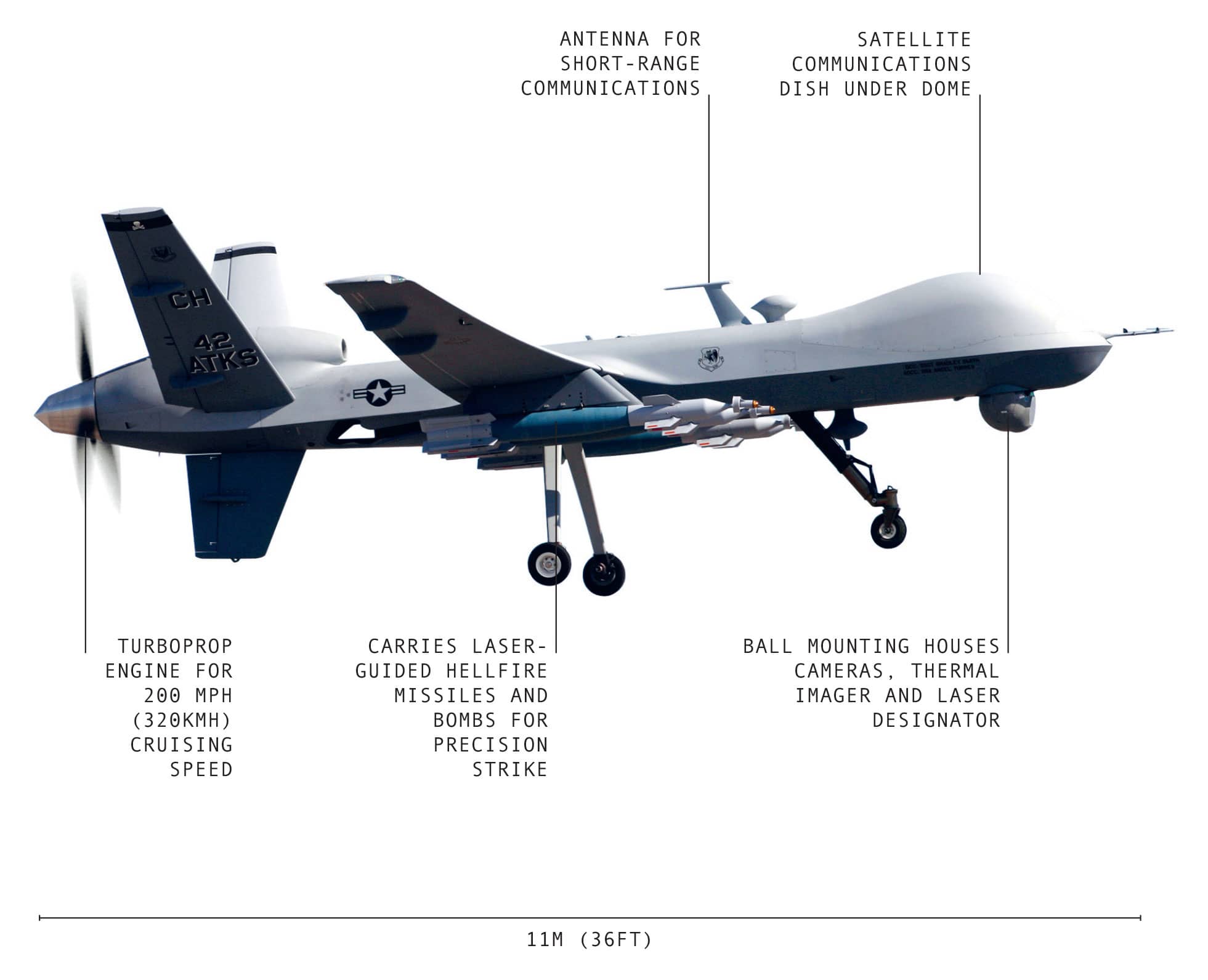
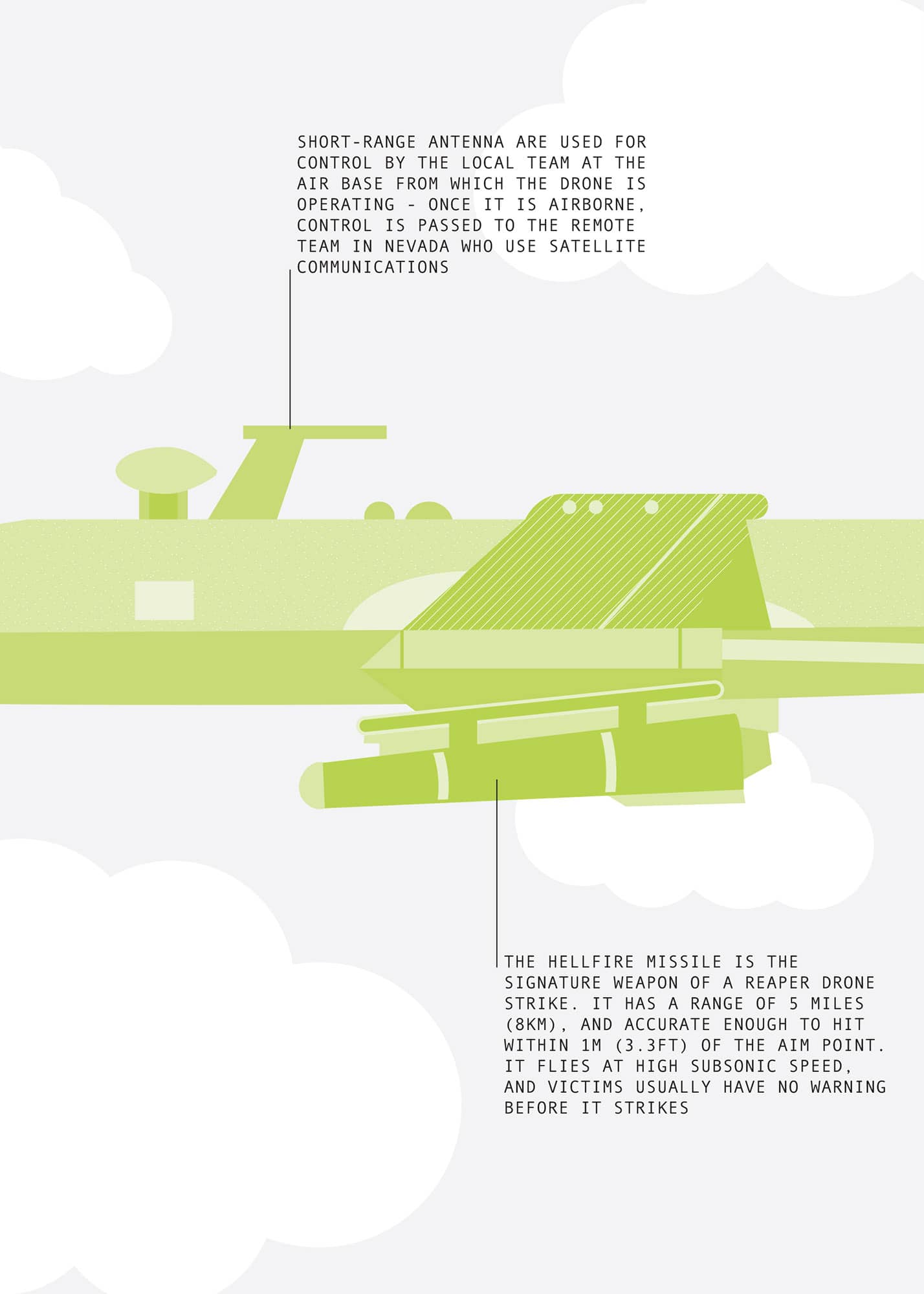
SGR-A1 SENTRY
Height |
1.2m (3.9ft) |
Weight |
117kg (258lb) |
Year |
2006 |
Construction material |
Steel |
Main processor |
Classified |
Power source |
External mains electricity |
‘Spring-guns’ have existed since the early days of firearms. At their simplest they are booby-traps that use a weapon, often a shotgun, with the trigger rigged to a tripwire, almost working – as they have been used – as a sentry soldier.
While the basic spring-gun was no more than a weapon attached to a wire, more sophisticated versions had several tripwires which can swivel to fire in the direction of the intruder. This brought them closer to being something like a robot. They became common in the eighteenth and nineteenth centuries, to prevent graverobbers from stealing bodies from graveyards. Known as cemetery guns they had the dual function of shooting at robbers and alerting the cemetery keeper to the intrusion. Cemetery guns were rented by the week by bereaved families to ensure that their loved ones remained undisturbed until their bodies were no longer of value to unscrupulous medical researchers.
The Hanwha Techwin SGR-A1, first installed in 2006, is a modern version of the spring-gun, a fully-automated robot sentinel to keep watch with unwavering concentration, twenty-four hours a day. It was built to help man the 160 mile (257km) ‘demilitarized zone’ (DMZ) between North and South Korea – one of the most heavily fortified borders in the world. South Korea has five thousand guard posts along this border, each with two guards, on shifts that change every two hours. That means an absolute minimum of twenty thousand soldiers are required to keep the border maintained. In practice, guard duty takes over forty thousand troops – about ten per cent of South Korea’s entire combat force. Automating this duty will free up a huge amount of manpower.
The border already had plenty of sensors and surveillance systems, but the SRG-A1 is a gun turret able to engage targets and detect them. It is a stationary unit with three low-light-level cameras and a thermal imager, along with software for picking out moving objects – people and vehicles – and tracking them. The developers claim it can follow humans from a distance of 2.5 miles (4km) in daytime, or 1.25 miles (2km) at night.
The SGR-A1 challenges anyone entering the area, giving a person an opportunity to identify themselves and give a password or to put up their hands. The robot can respond to the correct password thanks to voice recognition, while gesture recognition can detect ‘hands up’. If neither of these responses is detected, the robot can open fire.
The ‘escalation of force’ approach means the robot is likely to start with a nonlethal shot and then move up to lethal means if the target does not surrender. The robot is armed with a 5.56mm (0.22in) K4 machinegun and a 40mm (1.57in) grenade launcher. The latter can fire rubber bullets or other nonlethal ‘kinetic’ rounds. These only have a range of a few tens of metres, but if the target has been asked to give a password, it would presumably be close to the machine anyway.
There are plans to acquire one thousand SGR-A1s at a cost of a reported US$1 billion. A year-long pilot scheme in 2008 cast doubts over whether the system worked well enough, and a period of redevelopment followed, but by 2014 the system was apparently passed fit for service. An unknown number of units are now in operation, though details are limited for security reasons.
The SGR-A1 is controversial. Its manufacturers say it has a ‘man-in-the-loop’ mode, in which a human operator is responsible for pulling the trigger, as well as a ‘man-on-the-loop’ mode, where the operator just switches the robot on and lets it go. This second option means the SGR-A1 is perceived as a ‘killer robot’.
The DMZ is peppered with landmines, which are also capable of killing without being directly told to by a human operator, but the SGR-A1 has attracted far more comment. This is perhaps because a stationary lethal autonomous system could evolve into a mobile one. Minefields stay where they are put, but fleets of robots locating and targeting humans on their own initiative is a potentially alarming prospect.
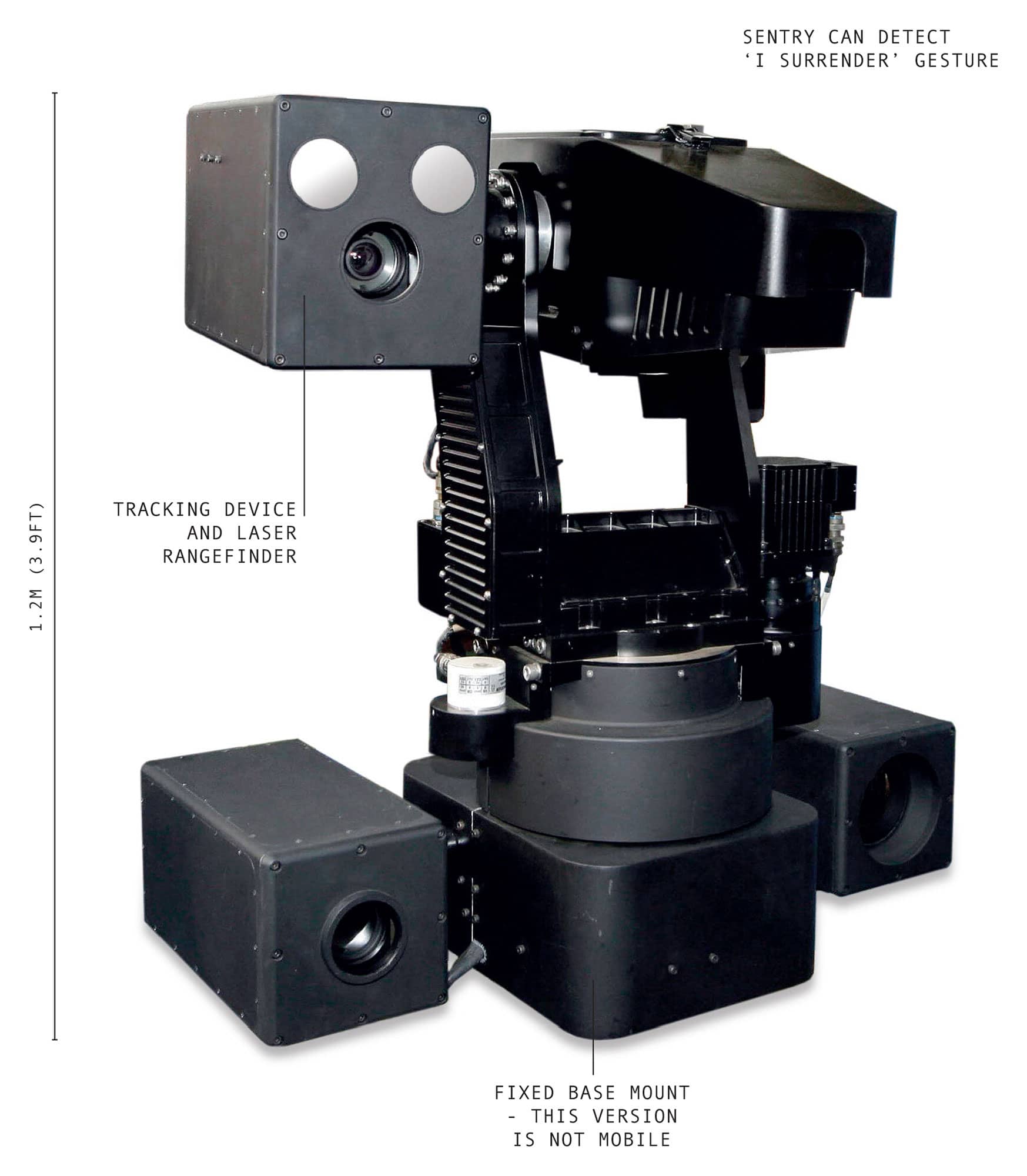
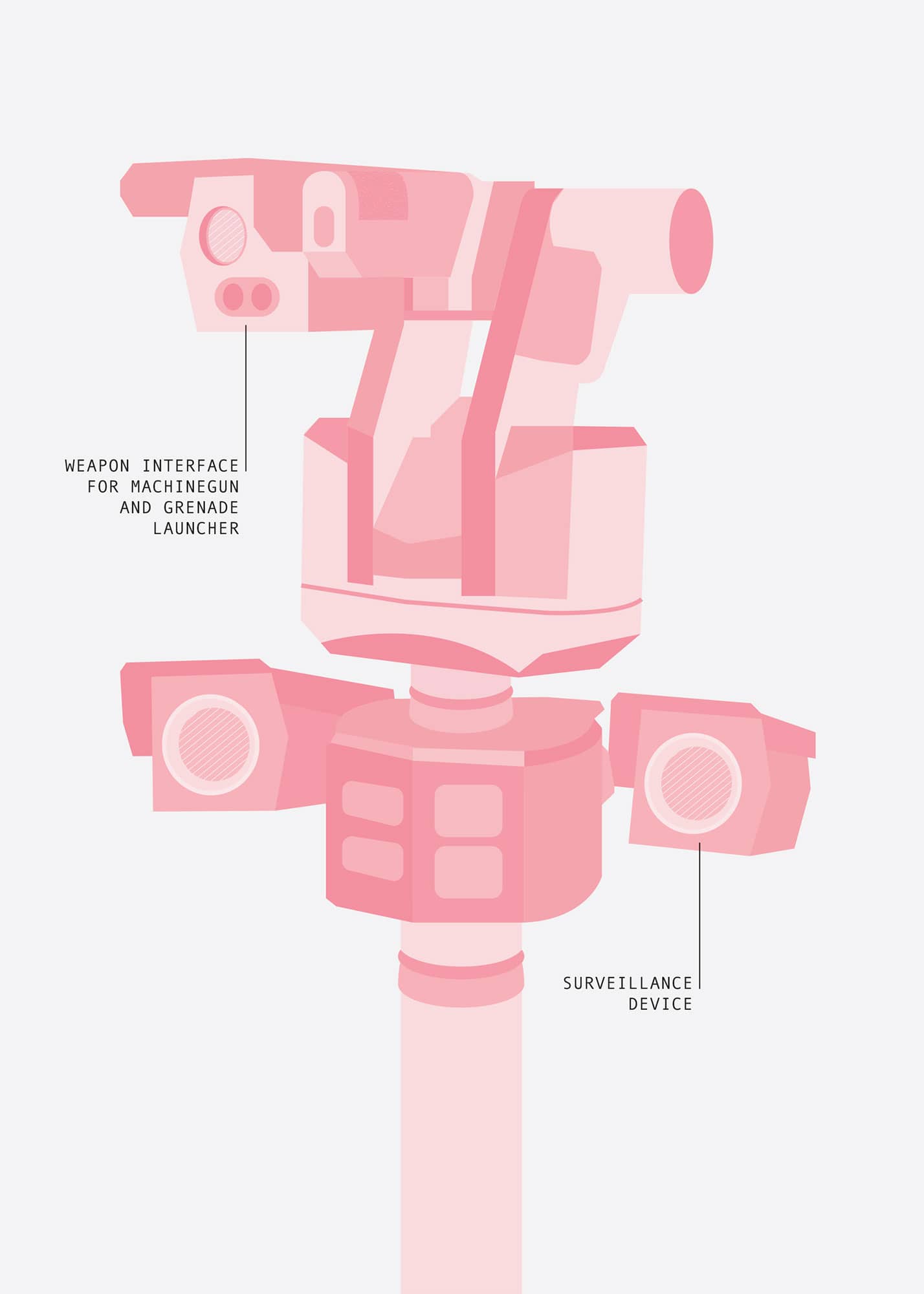
ECHO VOYAGER
Length |
15m (49.2ft) |
Weight |
31mt (34t) |
Year |
2016 |
Construction material |
Steel |
Main processor |
Classified |
Power source |
Battery and diesel |
It takes a special type of person to work on submarines, especially in wartime. Watery death is all too close, and the psychological effects of being in a confined, enclosed space for extended periods are considerable. Historically submarine crews have taken very high losses. It is a highly unnatural environment; so why not have the submarine run itself?
The unmanned submarine dates back to 1957 and the Self-Propelled Underwater Research Vehicle (SPURV) developed at the University of Washington. At 3m (9.8ft) long this machine could dive to 3,000m (9,840ft), far deeper than most manned submarines. Since then, this type of vehicle has been used by scientists and by commercial companies to inspect oil rigs and pipelines, as well as to help in wreck recovery and crash retrieval. Because only very-low-frequency (VLF) radio waves can penetrate seawater, unmanned underwater vehicles (UUVs) are controlled via a tether, or by sonar communication, which means they tend to stay close to their control ship.
Apart from a few exceptions, such as the underwater glider (see here), UUVs are small vehicles with limited autonomy, and require a surface ship to launch and retrieve them. Boeing is seeking to break the mould with a 15m (49.2ft) unmanned submarine called Echo Voyager. It will carry out missions lasting six months with no human input, and no support vessel. Most of the operational cost is in the support ship, so a robot submarine operating on its own could radically change the industry. It can stay at sea and provide continuous reporting – on the spread of an oil slick, for example – without needing to return to a manned surface vessel to recharge every day.
Rather than just having batteries, Echo Voyager operates on a hybrid system of battery and diesel power: while underwater it uses battery power, but as it comes to the surface it switches to a diesel generator that recharges the batteries.
One of the ongoing challenges with Echo Voyager is autonomy. The robot must make its own decisions in demanding situations – for example, if it gets lost or when it detects another vessel on a collision course. ‘The vehicle has got to understand what to do if it gets into trouble, make rule-based decisions and act in a way that allows it to stay safe and complete its mission’, says Lance Towers, Director of Sea & Land at the Boeing Phantom Works.
The long endurance and range – over 7,000 miles (11,000km) – means that the Echo Voyager’s onboard systems need to be far more reliable than those of other UUVs. Redundancy is built into critical systems: if one system breaks, a backup takes over so the Echo Voyager can make it back to port for repairs. Quite ingeniously, the Echo Voyager has a folding periscope mast that can be raised out of the water while the vessel remains submerged allowing it to communicate via satellite.
Echo Voyager’s size is also one of its key features. Many times greater than other UUVs, it has room for an enormous payload bay that brings flexibility. UUVs are usually equipped for a single type of mission, such as surveying the seabed, but the Echo Voyager can carry tools and instruments for a range of tasks. It can also act as the mothership for a shoal of smaller unmanned submarines, releasing them underwater and retrieving them.
Echo Voyager was not designed for a specific mission, but the company hopes that, like previous projects, such as the 737 airliner, it will fulfil both civilian and military roles. There is potential here for such undersea robots to take on roles that include locating and neutralising underwater mines, launching unmanned aerial vehicles, tracking submarines, reconnaissance and what the US Navy refer to as ‘payload deployment’ which generally means dropping off sensors but can also include laying mines. In other roles, the Echo Voyager may find itself shedding new light on the dark deep of the sea, exploring and exploiting new mineral resources and examining ecosystems in unprecedented detail. Either way, its creation will almost certainly lead to advanced models, vessels that will not be tied to a ship but can set off on their own.
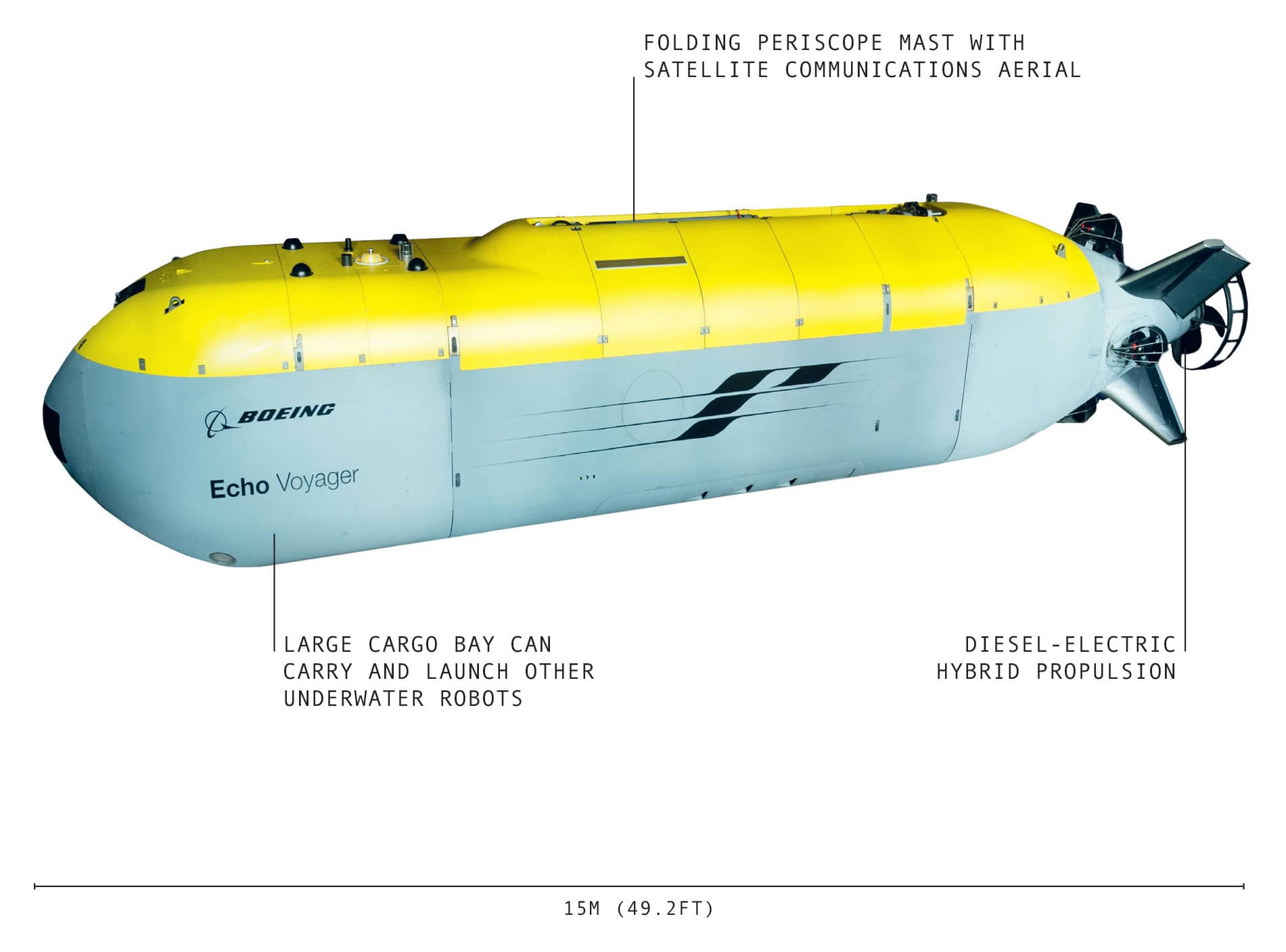
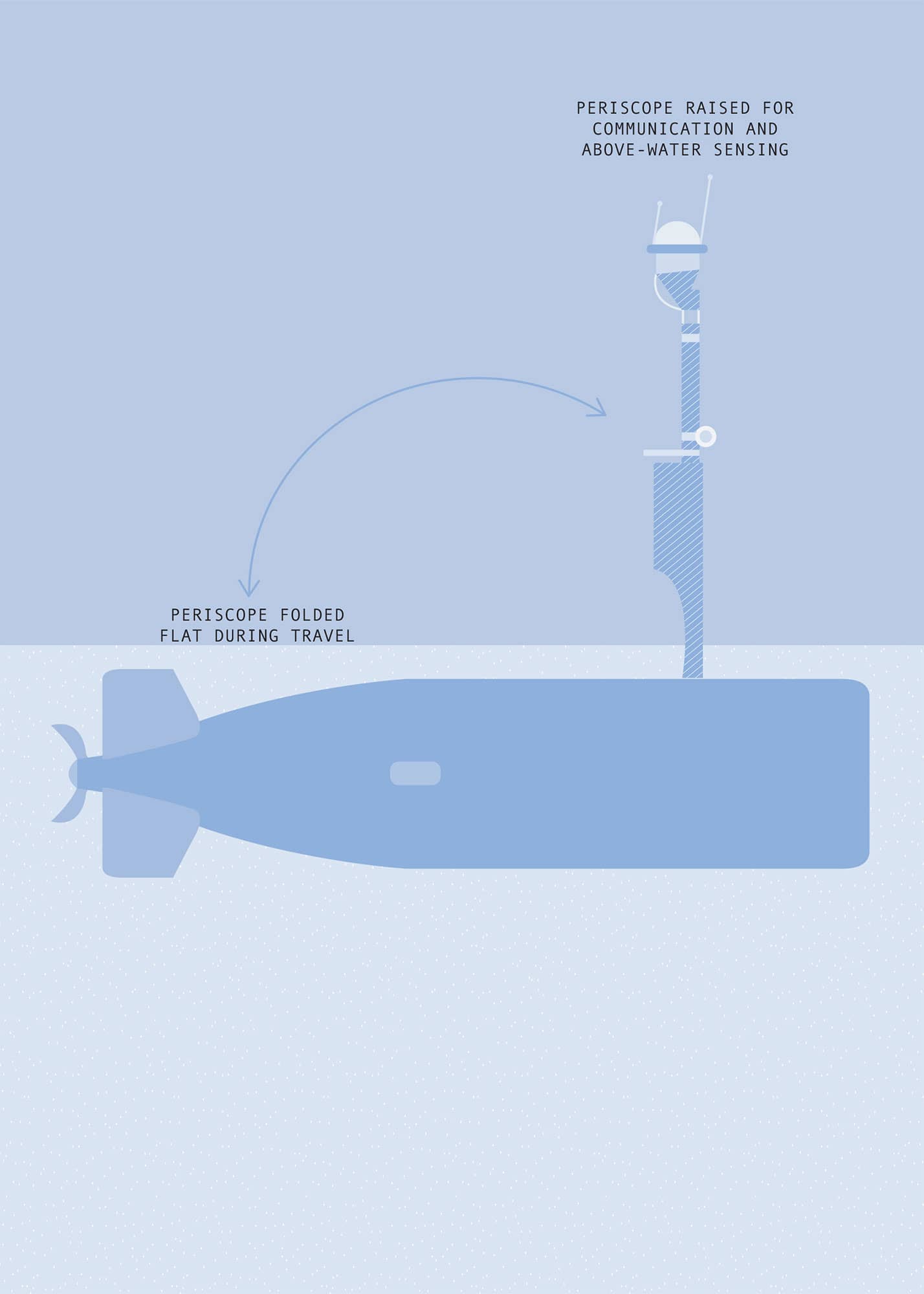
WINGMAN
Height |
1.78m (5.8ft) |
Weight |
4mt (4.4t) |
Year |
2000 |
Construction material |
Aluminium |
Main processor |
Proprietary processors |
Power source |
6.6 duramax diesel 750HP |
In 2001, the US Air Force eventually accepted the idea of missile-firing drones – though only after the CIA threatened to develop its own – the US Army, however, has taken a more cautious approach. A project called Wingman aims to build confidence in armed unmanned ground vehicles, so they can stand in the front line in the place of soldiers.
Arming robots is easy enough. There were several robot weapon programmes in the 1980s, including the TMAP, a remote-controlled vehicle that could launch antitank missiles, keeping the operator away from enemy fire. However, in 1987, Congress prohibited spending on armed ground robots, believing that money was being wasted on over-optimistic projects.
Twenty years later, TALON SWORDS was deployed to Iraq. This was an armed version of a bomb-disposal robot, a bit like a giant PackBot (see here) with a machinegun. It was a remote-controlled device and had no capacility to fire weapons on its own. It was never used, apparently for political rather than operational reasons, as there were concerns that the media would raise the alarm over ‘killer robots’. US tactical armed robots have been stuck at the testing stage ever since.
The latest concept is a robotic ‘wingman’ for tank units. A new version of the M1 Abrams tank will feature an automatic loader. The crew member who previously loaded the main gun will now have a new role supervising robots. The Wingman will lead columns of tanks, making it the first to be hit by mines or ambushes. It will scout out suspected enemy positions, and will ultimately fire weapons under the direct control of a human operator.
The programme will build on previous developments, in particular the Ripsaw unmanned vehicle created by Howe & Howe Technologies Inc. This was built as a backyard garage project and submitted for a DARPA challenge in 2005 before being taken up by the US Army.
Ripsaw is the size of a sports utility vehicle (SUV) and weighs 4mt (4.4t), but has exceptional agility, accelerating from 0–50mph (0-80kmh) in 5.5 seconds, thanks to a six-litre diesel engine and a lightweight tubular chassis derived from NASCAR racing cars. This high speed allows Ripsaw to keep up with road convoys, and it can scale a 1.5m (4.9ft) obstacle or climb a forty-five-degree slope.
The US Army developed the sensors and software known as Safe Operations of Unmanned systems for Reconnaissance in Complex Environments programme (SOURCE) for machines like Ripsaw to drive around autonomously. SOURCE allows robot vehicles to drive at 30mph (48kmh) on roads or 6mph (9.6kmh) in busy urban terrain, avoiding vehicles, people and animals. SOURCE can even read and interpret road signs.
In the case of the Wingman, an operator will take control using a Head-Aimed Remote Viewer (HARV), resembling a virtual-reality headset which gives a robot’s-eye view. When the operator turns their head, the robot camera rotates to follow.
The US Army has also developed an Advanced Remote/Robotic Armament System (ARAS) for its robots. This is based on existing turrets with some added features. If the weapon jams, it can be cleared remotely, for example. Rather than having one type of ammunition, there is a carousel of different bullet types that can be selected at will. The options may include standard rounds, reduced-range rounds for urban operations and ‘nonlethal’ riot-control rounds. ARAS can fire single shots with high precision; a fixed mount gives as much stability as a sniper rifle. It can also fire bursts or continuous fire as necessary.
The Wingman program envisages slow progress, and does not anticipate that a vehicle will be fielded until 2035. This will ensure a high level of confidence, and ensure that the robots are safe and remain under control. However, by that time battlefields could well be overrun by robots from other nations, such as the Russian Comrade in Arms, built by Kalashnikov (see here).
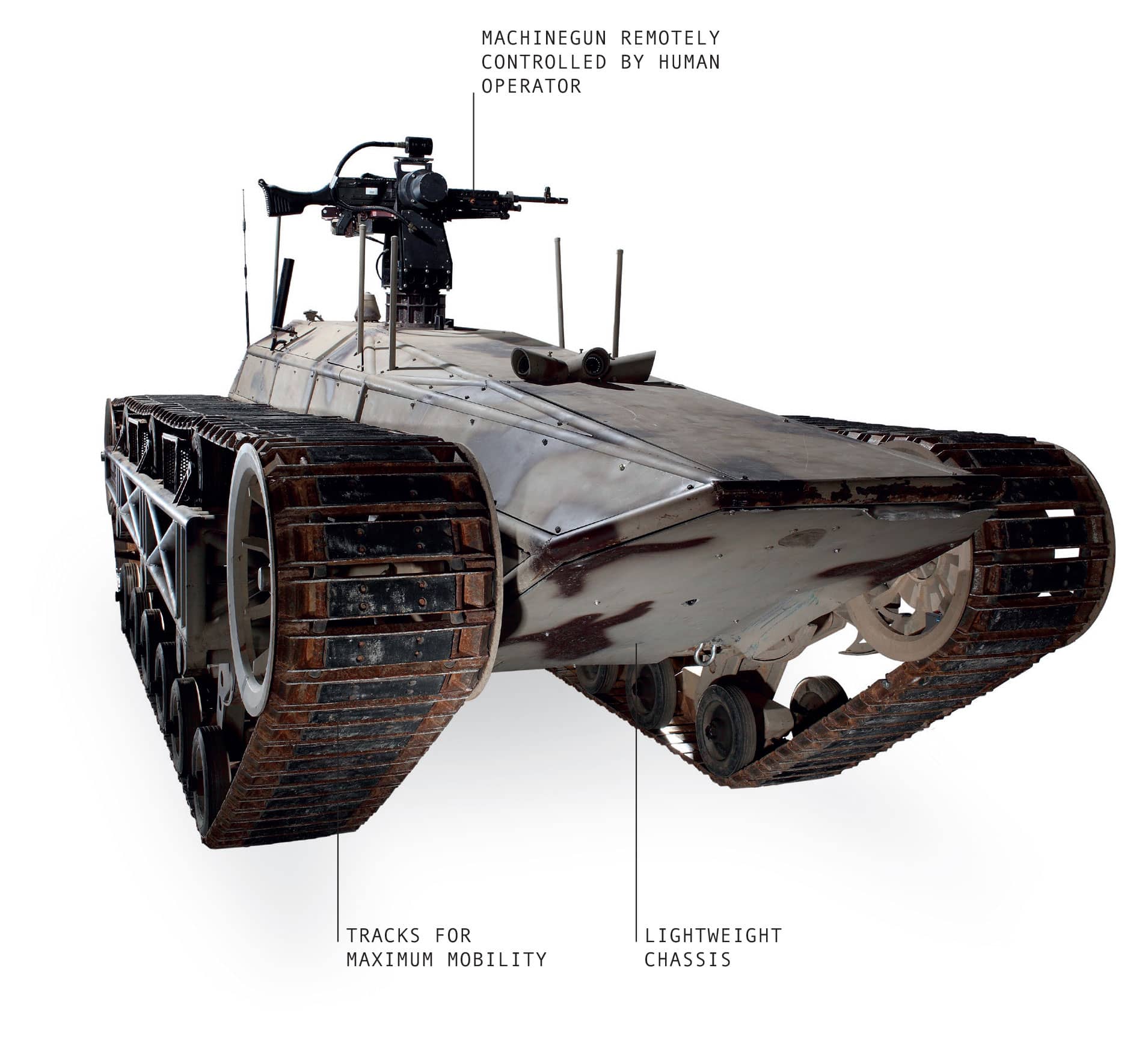
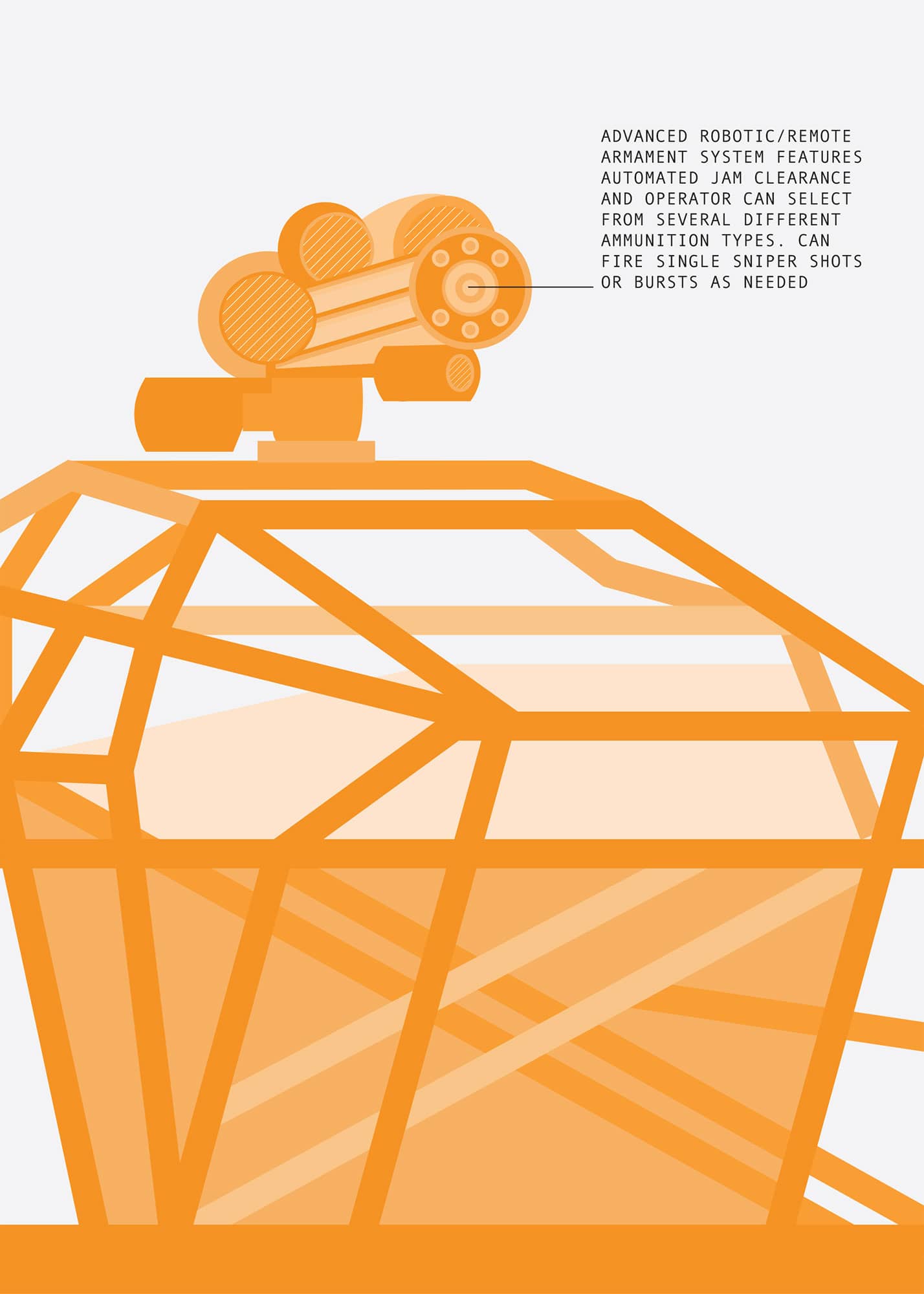
GHOST MINITAUR™
Height |
40cm (15.75in) |
Weight |
6kg (13lb) |
Year |
2015 |
Construction material |
Steel |
Main processor |
NVDIA |
Power source |
Battery |
Machines like PackBot (see here) are fairly mobile, but they cannot compete with animals of a comparable size. Legs are the ultimate in ground mobility, and can cope with steep slopes, rugged terrain and obstacles that defeat even caterpillar tracks. Researchers have been trying to build mobile walking robots for more than a century, and their efforts are finally bearing fruit.
The BigDog robot developed by Boston Dynamics was the showpiece of the US Army’s programme for a robot mule to carry soldiers’ gear. This ran from 2005 to 2015; BigDog was described as ‘the world’s most advanced quadruped robot’. It looked great in demonstrations and racked up millions of YouTube views. Ultimately, though, BigDog lost out to wheeled designs for load carriers, as its innovative hydraulics were too noisy and expensive.
By contrast Minitaur is a dog-sized, affordable, practical robot. Its maximum speed, in a springy running mode on four legs, is about 5mph (8kmh). Not only can it cross rubble-strewn terrain impassable to wheeled and tracked robots, it can go up stairs and clamber over chain-link fences. Jiren Parikh, CEO of the makers, Ghost Robotics, says that it can even climb trees.
While robots like BigDog use hydraulics, Minitaur is entirely based on electric motors, which are simpler and cheaper. Its distinctive bouncy gait is closely linked to its main design features. The robot is powered by direct drive with no gearing. The company slogan is ‘Robots That Feel the World™’ and the motors themselves act as sensors – they are programmed to act like a spring-damper system, responding to changing forces. Even though the legs are actually rigid, the control system makes the robot bouncy.
The direct-drive system is agile enough to cope with slippery surfaces such as ice, or crumbling slopes. It responds almost instantly when a leg slips and makes the appropriate compensating movement to stabilise it. Minitaur can crawl on its belly, sidle sideways, or rear up against a vertical surface to reach objects above the ground, like an excitable dog at a kitchen counter. It can open doors and climb fences using manipulators on the ends of its legs for grasping. Minitaur’s springiness allows it to jump up steps, or across a trench 50cm (20in) wide. Its advanced control system means it can even balance on two legs and walk like a biped for about twenty paces. In future, developers plan for it to learn new tricks, such as climbing different obstacles, with an artificial intelligence (AI) system.
The original version of the Minitaur was remote controlled, but the production version has stereo cameras and a high degree of autonomy. It can travel between points and avoid obstacles on its own. Batteries give enough power for more than four hours of operation, and the Minitaur can roam for about 10 miles (16km) on a single charge.
The first major customers are likely to be the US military, who have shown interest in Minitaur as a sensor platform for tasks that include bomb disposal and urban reconnaissance. Squads of Minitaurs could go ahead of troops and explore the interiors of buildings and tunnels. In the commercial world, the Minitaur might be useful in the mining industry for safety sensing, but agriculture may prove to be the biggest market. Farmers already use aerial drones for surveying their fields on a daily basis, to assess crop health. But drones are less useful for taking action, such as pulling up weeds, gathering soil samples or applying fertiliser. Gangs of Minitaurs could progress through fields carrying out routine tasks, recharging themselves from a base station as needed.
While Minitaur is still relatively untried, the design looks promising. The direct drive reduces the weight, cost and complexity. Having no gearbox means there is nothing to damage, making Minitaur highly robust. Plus, the electronics are all commercial off-the-shelf components, making it cheaper than similar robots. Minitaur may finally be able to deliver what legged robot researchers have been looking for over the past century: a practical, affordable machine, taking robots into uncharted territory.
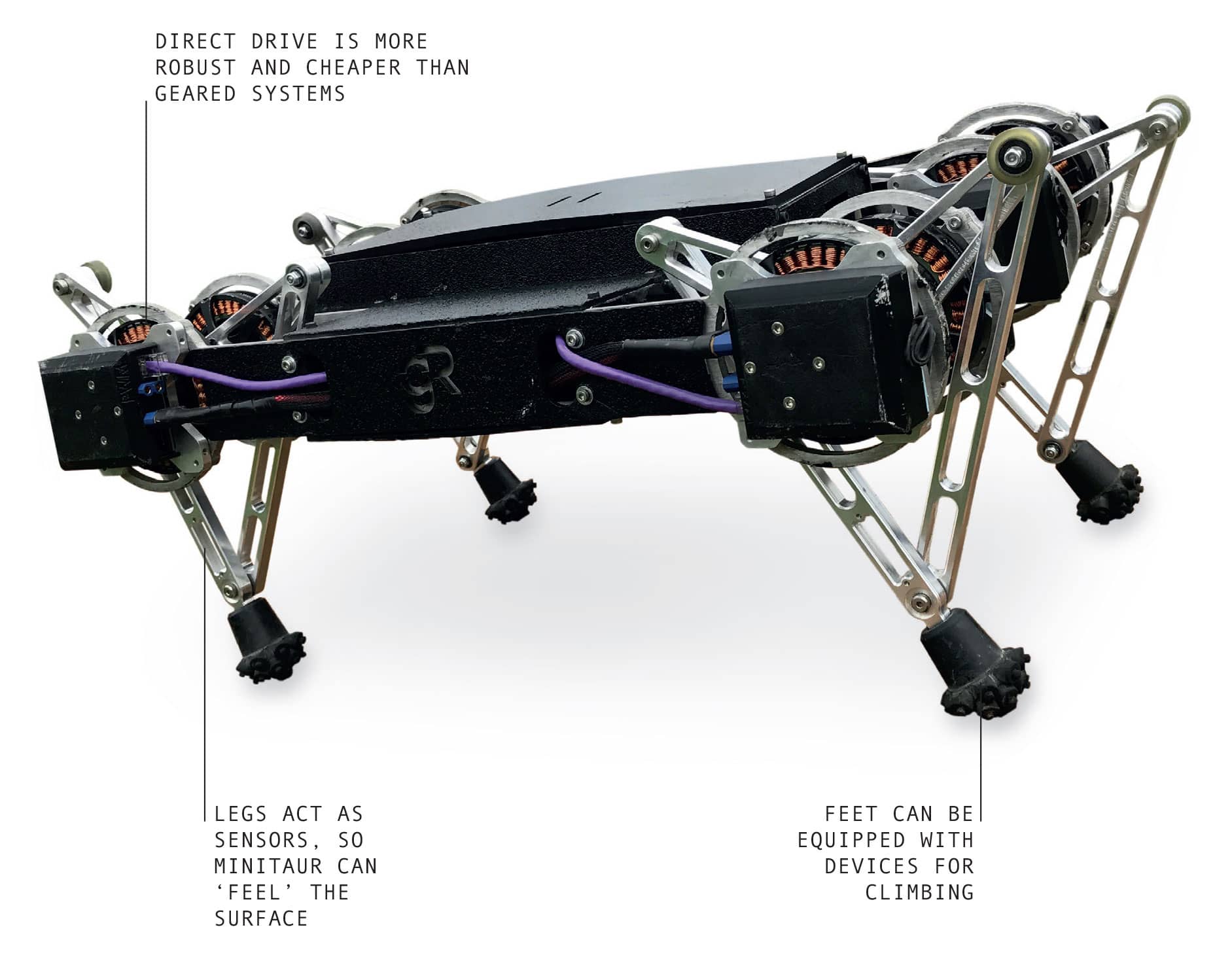
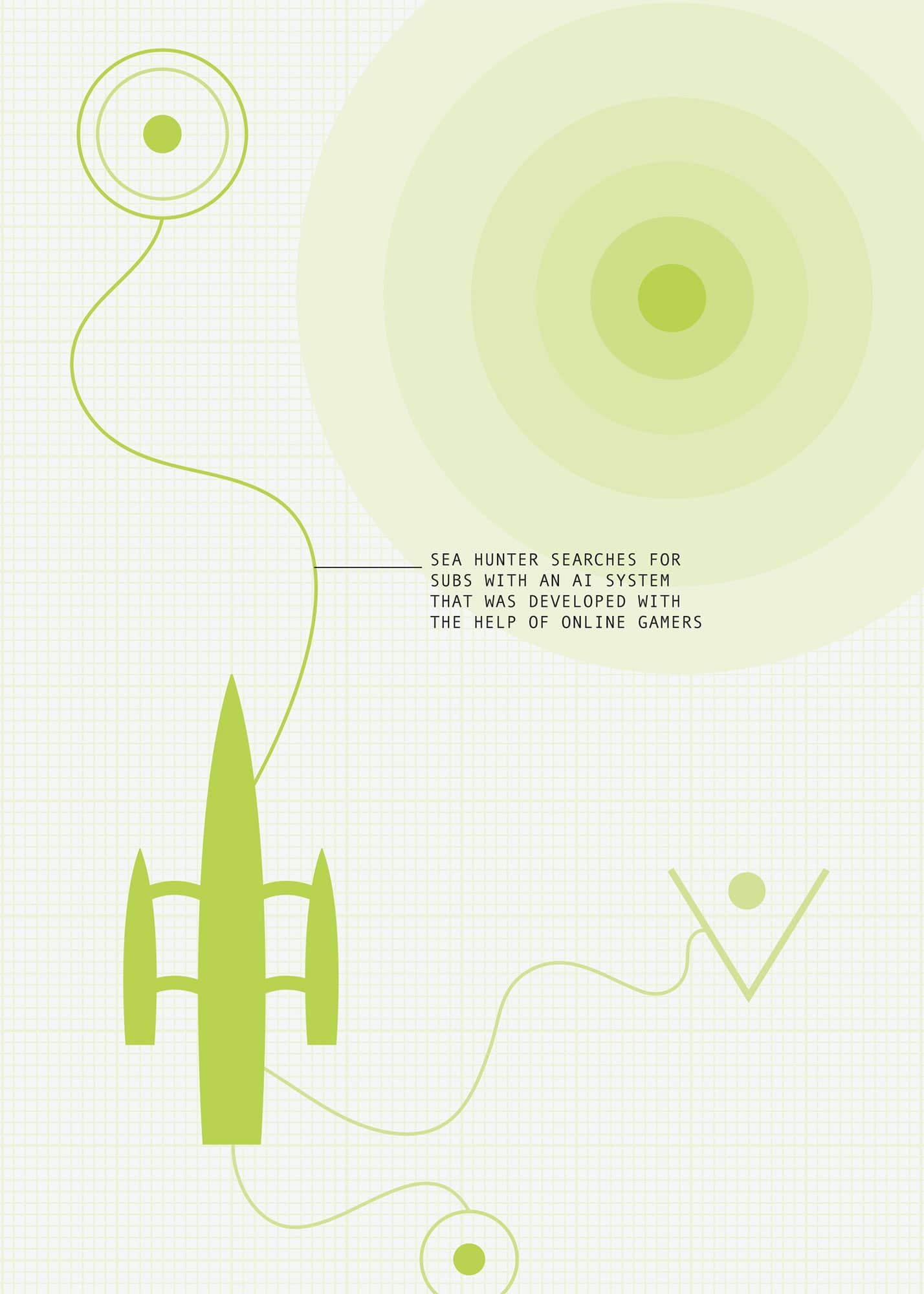
SEA HUNTER
Length |
40m (131ft) |
Weight |
135mt (149t) |
Year |
2014 |
Construction material |
Composite |
Main processor |
Classified |
Power source |
Diesel |
Submarines pose the biggest threat to warships in modern naval warfare. Armed with an array of missiles and torpedoes, they can sink anything without warning. While aircraft carriers may provide global striking power, they can only operate behind a protective screen of surface ships, aircraft and friendly submarines to keep them safe from underwater attackers.
The commonest vessels for antisubmarine warfare are destroyers. They bristle with active and passive sonar and other sensors, and are armed with torpedoes and missiles. A typical destroyer is 150m (500ft) long with a crew of three hundred, and of course they are expensive to acquire and operate. Navies can only afford a few destroyers, and they have a difficult job when looking for hidden opponents in the vast oceans.
Enter Sea Hunter. This submarine-hunting robot ship can do the job of a destroyer without the manpower, and at a fraction of the cost. It is equipped to locate the latest and quietest submarines, and has the speed and endurance to follow them wherever they go.
Sea Hunter is a trimaran that resembles a giant Polynesian war canoe, with a slim hull and two outriggers for stability. It is made of lightweight carbon-composite materials and was developed by DARPA under a programme called Antisubmarine Warfare Continuous Trail Unmanned Vessel. With no human crew to accommodate, everything is remarkably compact: there are no cabins, bunks, galleys or other occupied spaces. The only concession to humanity is a detachable pilot house that has been added for sea trials, during which the Sea Hunter remains technically under human command. Much of the vessel is taken up with fuel tankage for 40mt (44t) of diesel – enough to carry out a continuous three-month patrol. Sea Hunter can operate in rough seas up to about sea state 6, which means waves 6m (20ft) high and officially described as ‘very rough’.
Satellite communication keeps Sea Hunter in touch with human operators, but ships are harder to control remotely than aircraft because of the volume of sea traffic. Sea Hunter looks after itself, with radar and electronic systems to spot other ships and avoid collisions, and a camera-based system with optical recognition software as a backup.
Like any other ship, Sea Hunter has to follow the Convention on the International Regulations for Preventing Collisions at Sea, the maritime version of the Highway Code. This dictates when a vessel should give way. One rule is that manoeuvres must be visible to the operator of the other vessel, so Sea Hunter is programmed to make large, sweeping course corrections rather than the subtle turns that a navigation computer would otherwise adopt.
Though Sea Hunter is unarmed, it tows an array of sensors for submarine detection. DARPA will not give details, but says that, owing to Sea Hunters ‘unique characteristics’, it will be able to employ ‘non-conventional sensor technologies’. This might simply mean that, unlike a manned vessel, it can be completely silent, making sonar more effective for picking up the slightest sound. DARPA say it will ‘achieve robust continuous track of the quietest submarine targets’. Sea Hunter is equipped with artificial intelligence (AI) to play the cat-and-mouse game of submarine hunting against a clever adversary without assistance. DARPA crowdsourced some of the algorithms, setting up an online submarine hunting game for players to try out innovative ideas.
Trials of Sea Hunter are just about complete and its developers can already see how the robot ship could take on many other tasks beyond submarine hunting.‘What we’ve realized over the course of the programme is that it’s a truck’, says programme manager Scott Littlefield. ‘It’s got lots of payload capacity for a variety of different missions.’
Inventors have been offering remote-controlled boats to navies since Nikola Tesla’s radio-controlled demonstration in 1898. For the most part, they have been unsuccessful. Combining, as it does, long endurance, autonomy and low cost, the Sea Hunter might just be the vessel to turn the tide.

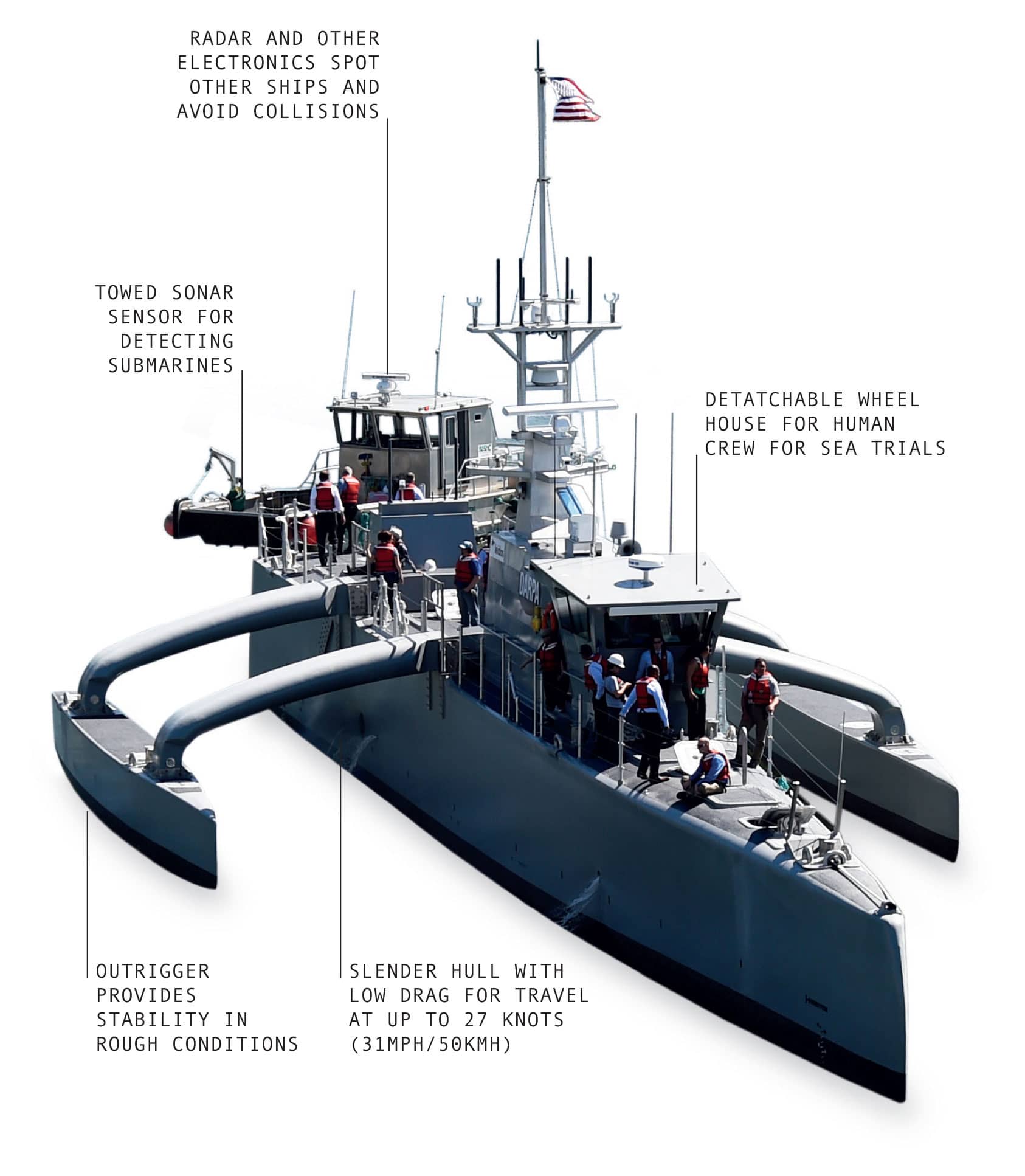
COMRADE IN ARMS
Height |
3.5m (11.5ft) |
Weight |
7mt (7.7t) |
Year |
2016 |
Construction material |
Steel |
Main processor |
Classified |
Power source |
Diesel |
There is no doubt that robots can swell the ranks of armed forces, which often find it difficult to get enough recruits. One obvious benefit from using robots is that they can take up positions in the front line where casualties are heaviest, reducing human losses. While many approach armed autonomous robots with caution, owing to the risks of ‘friendly fire’, Russia is taking a more robust stance. Its view is that such machines are not only inevitable, but that their deployment will be a good thing.
During the Cold War, Russia did not compete with NATO in sophisticated electronics. Instead, it churned out simple, but effective, weapons in massive quantities. The Kalashnikov assault rifle and the RPG-7 rocket launcher epitomised this approach. Russia had defeated a technically superior army during the Second World War by weight of numbers, but at the tragic cost of many lives. Perhaps it is this history that makes the Russian public sensitive to army casualties and the government keen to explore a robotic answer.
Russia was arguably the first to field armed robots, with the remote-controlled ‘Teletanks’ it used in the war against Finland in 1939. There had been little development since then until, in 2013, the industry was set in motion, with many companies pitching their combat robots to the Russian military. Some, such as the Stelok ‘Sharpshooter’, Platform-M and Boar, resemble bomb-disposal machines with guns, and are able to move around inside buildings. Others are the size of tanks and include the Whirlwind, which is a robot version of the BMP-3 combat vehicle, the Russian Army’s main armoured personnel carrier.
The Soratnik or ‘Comrade in Arms’, developed by Kalashnikov Concern, was unveiled in 2016 and lies somewhere in the middle of the size range, being as big as a large car and weighing a hefty 7mt (7.7t). It is large enough for good mobility over rough terrain, but small enough to be procured in large numbers and issued widely. It runs on tracks and has a road speed of 25mph (40kmh). As its name suggests, the Comrade was designed to support infantry units in combat, and its turret is equipped with a machinegun – a Kalashnikov, of course.
It can also carry heavier weapons, such as grenade launchers. An alternative antitank version carries eight guided missiles. Being armoured, the Comrade is protected from small-arms fire and shell fragments. In fact, it is only vulnerable to large-calibre weapons and antitank missiles.
One defining facet is a secure communications system, which can be controlled from up to 6 miles (9.5km) away. It can carry and launch two small Zala drones, also made by Kalashnikov, to scout for targets. What really distinguishes it from Western equivalents is its software. You might expect a machine like this to be kept on a tight leash, but the Comrade has various levels of autonomy allowing it to take control of its own driving and weaponry. The Russian move towards autonomous robots comes partly from an acceptance that radio-frequency jamming is likely to be increasingly common on the battlefield. Communications are a weak spot for military robots, and many counter-drone systems work by jamming the link between the drone and the operator. If the link is lost, a robot needs to be able to act for itself. As far as the Russian are concerned that includes fighting solo.
At the extreme end, the Comrade can operate independently. Its manufacturers claim that it can detect, identify and engage targets – presumably telling friend from foe – from 1.5 miles (2.5km) away. With the ability to shut down into a ‘sleep’ mode to conserve power and wait for an opponent to appear for up to ten days, it allows a group of Comrades to hold a defensive position on their own for an extended period.
If Kalashnikov’s ground robots prove to be as rugged and affordable as their assault rifles, they may start to fill the front ranks in future wars.
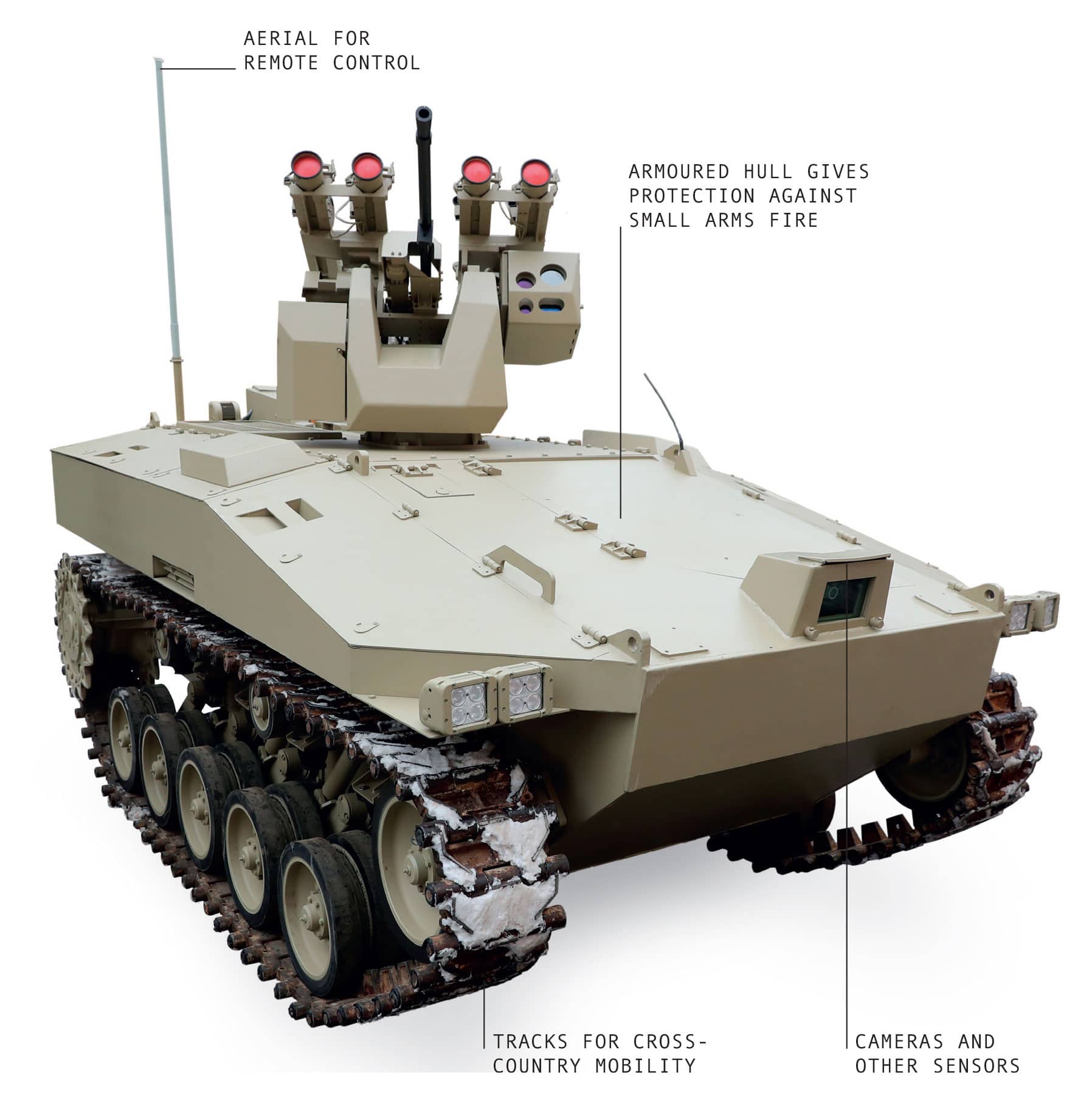

SWITCHBLADE
Wingspan |
70cm (27.5in) |
Weight |
up to 2kg (4.4lb) |
Year |
2011 |
Construction material |
Composite |
Main processor |
Classified |
Power source |
Lithium battery |
The Switchblade drone is officially known as a ‘tactical loitering munition’. It looks like a drone, it flies like a drone and it is controlled like a drone, using the same control unit. The difference is that Switchblade is designed strictly for one-way missions, diving into targets and destroying them with an explosive warhead. It is the first of a new breed of lethal robots that may change warfare – from boots on the ground to drones in the air.
Switchblade’s origins go back to the early 2000s. Special Forces in Iraq and Afghanistan had started using small, hand-launched drones called Ravens, also developed by Californian company AeroVironment™. These were extremely popular because they provided a way of seeing over the next ridge or into the village ahead. Unlike the big Predator drones that were flown by the air force, Ravens were carried by foot soldiers and could be sent up at a minute’s notice to check a perimeter or fly ahead of a convoy to spot ambushers.
The only problem with the Raven was that, while you could see the enemy, there was nothing you could do anything about it. Raven operators had to watch helplessly as insurgents set up mortars or took up firing positions to attack friendly forces.
Project Anubis, developed by the US Air Force for the US Army, aimed to develop a small drone. This resulted in AeroVironment’s Switchblade, unveiled in 2011. The drone is carried in a tube like a miniature bazooka and launched into the air using compressed gas. After launch, its wings unfold – hence the Switchblade name. An electric propeller drives it for fifteen minutes at around 50mph (80kmh), giving a range of several miles. It sends back the stream from visible-light and thermal-imaging cameras via a secure, jam-proof data link. Once a target is located, the operator locks onto it and the Switchblade automatically pursues and destroys it, even if it is employing rapid evasion tactics.
Launching a Switchblade from behind cover, an operator can identify and engage a target several miles away, without ever being seen. The warhead is powerful enough to destroy lightweight vehicles, such as the pickup trucks favoured by insurgents, but is highly directional – it is known as the ‘flying shotgun’ – so it can hit its target, leaving people a few metres away unharmed. Switchblade can attack from any direction, including a vertical dive. This means most cover is useless, including trenches and foxholes. It can enter buildings through windows or open doors.
One of Switchblade’s key features is its ‘wave-off’ function. If, as the drone approaches, the operator sees the target has been misidentified – for example, it turns out to be an unarmed civilian – they can cancel the attack. The drone breaks off and circles, ready to find a different target. No other weapon can do this, allowing Switchblade to be used in situations where the ‘rules of engagement’ prohibit all other weapons.
Several thousand Switchblades have been used and they have reportedly been highly effective in action, although few details have been released. Many aspects of the weapon are still classified.
Switchblade now has many competitors, both in the US and elsewhere, for obvious reasons. A squad with Switchblades, either attacking or defending, can see and attack enemies without ever being spotted themselves. Actions fought with rifles from a few hundred metres away may become as rare as bayonet charges.
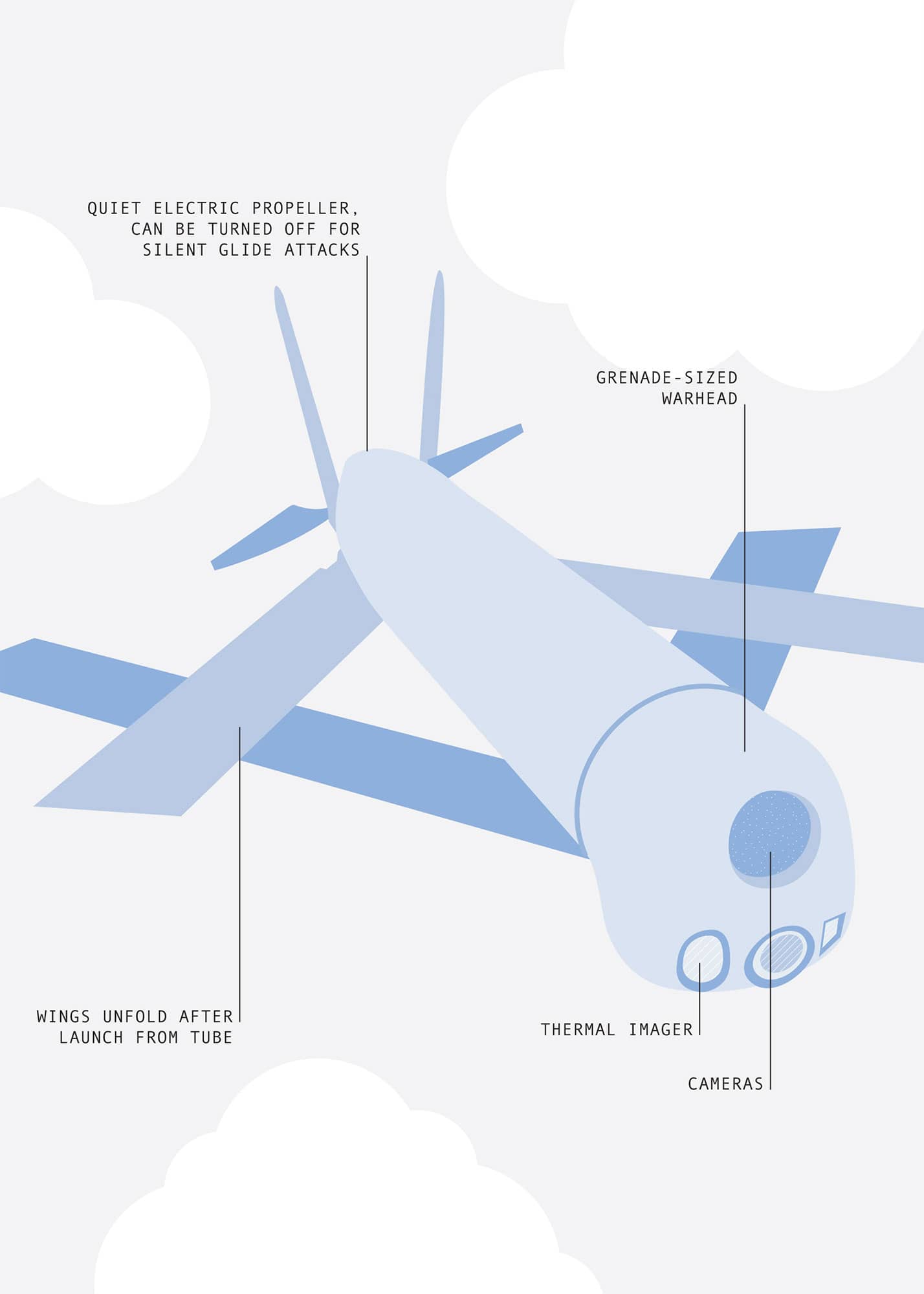
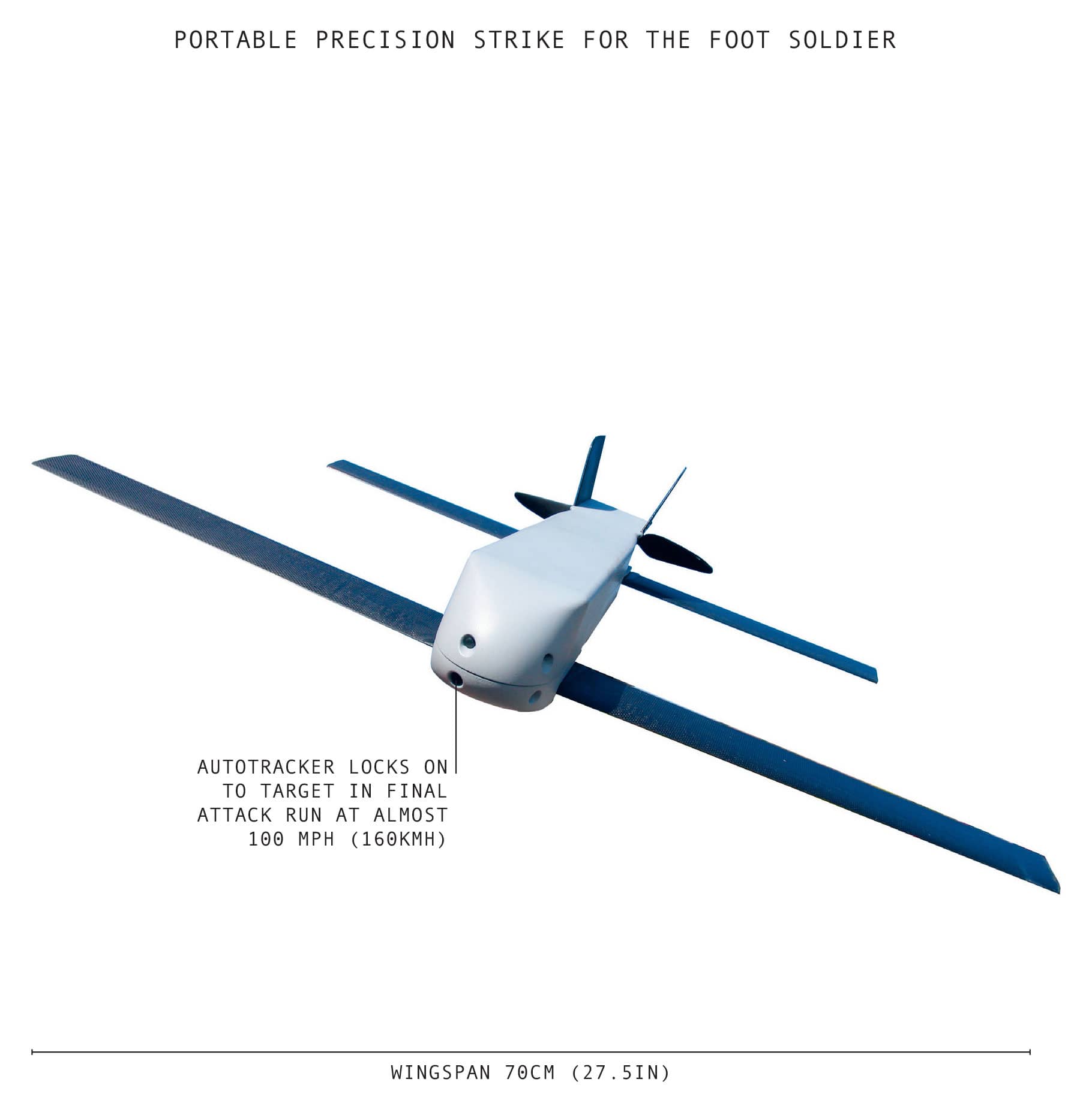
COVERT ROBOT
Height |
60cm (24in) approx. |
Weight |
20kg (44lb) approx. |
Year |
2008 |
Construction material |
Composite |
Main processor |
Commercial Processors |
Power source |
Lithium battery |
Military ground robots are robust. By human standards, they are also conspicuous and clumsy. Sometimes, however, stealth is necessary – a requirement that led to the world’s first robot spy.
In 2011 Lockheed Martin’s Advanced Technology Laboratories at Cherry Hill, New Jersey, revealed details of what they called their Covert Robot, a machine able to evade detection by human sentries. It runs on four quiet rubber wheels, and expertly maps its environment by building up a 3D model of its surroundings, able to read lines of sight almost instantly. Its true secret weapon, though, is an ability to tell where it might be seen. It is in effect, a working spy.
The Covert Robot has four ways of avoiding detection. Most simply, at night it stays away from areas that are well lit and sticks to the shadows. Where there are known sentries, it avoids anywhere that is in their field of vision, utilising its four microphones to recognise approaching footsteps and determine their direction. When it hears someone coming, it moves out of their path, ensuring that it will not be seen, but also making sure that it has multiple routes of escape and avoiding being caught in a dead end.
The developers say that the robot has a ‘multi-layered world model’ – that is, it creates its own mental picture of the world, with obstacles, open paths, threats and light sources all factored in. The robot assesses every possible route for chances of being spotted, and weighs them up against its objective. The robot will take a risky route, but only if absolutely necessary, preferring to take lengthy diversions to reduce the risk. This world model changes second-by second, responding to new opportunities such as open doors, or new threats, including patrolling guards.
The first Covert Robot is a simple machine built at low cost out of commercial robot parts. It is essentially a test platform for trying out the software for covert behaviours in a real environment. A more advanced version will have more sophisticated hardware: it will be quieter and less conspicuous, as well as more mobile. This will at least include being able to climb stairs. The best hardware might be a humanoid robot like Boston Dynamics’ Atlas (see here), which could pass for human from a distance, making it much less likely to attract attention if seen.
The US military appears to have funded further work in this area, including development on ground robots for ‘persistent surveillance’. These take up a position to observe a particular spot for a prolonged period, and can camouflage themselves – for example, using a robotic arm to cover themselves with leaves or branches to make them harder to see.
The US Navy has carried out more advanced work on deceptive software, aiming to emulate the deception and distraction techniques of animals. This includes behaviours such as small birds mobbing a larger predator even when they are too weak to harm it, and squirrels misleading others about where they have cached nuts by pretending to check non-existent caches. A Covert Robot might use similar techniques to lure guards away from their position, or to intimidate or bluff them into fleeing or surrendering.
These functions show an implied form of self-awareness: the robot has to consider how it appears to others. This human attribute, whilst vastly impressive, raises questions about the use of robots in warfare.
The Law of War requires soldiers to wear uniforms to distinguish them from civilians; anyone not identifiable may be an ‘unlawful combatant’. There is no such law for robots, and a robot would not be troubled by the prospect of being captured and shot. The original fictional Terminator was an ‘infiltration unit’ able to imitate specific human voices. Real covert robots may have a whole range of tricks at their disposal to avoid and deceive humans to complete their mission. They may prove to be even more effective assassins than Reaper drones (see here), but also far more ethically troubling.
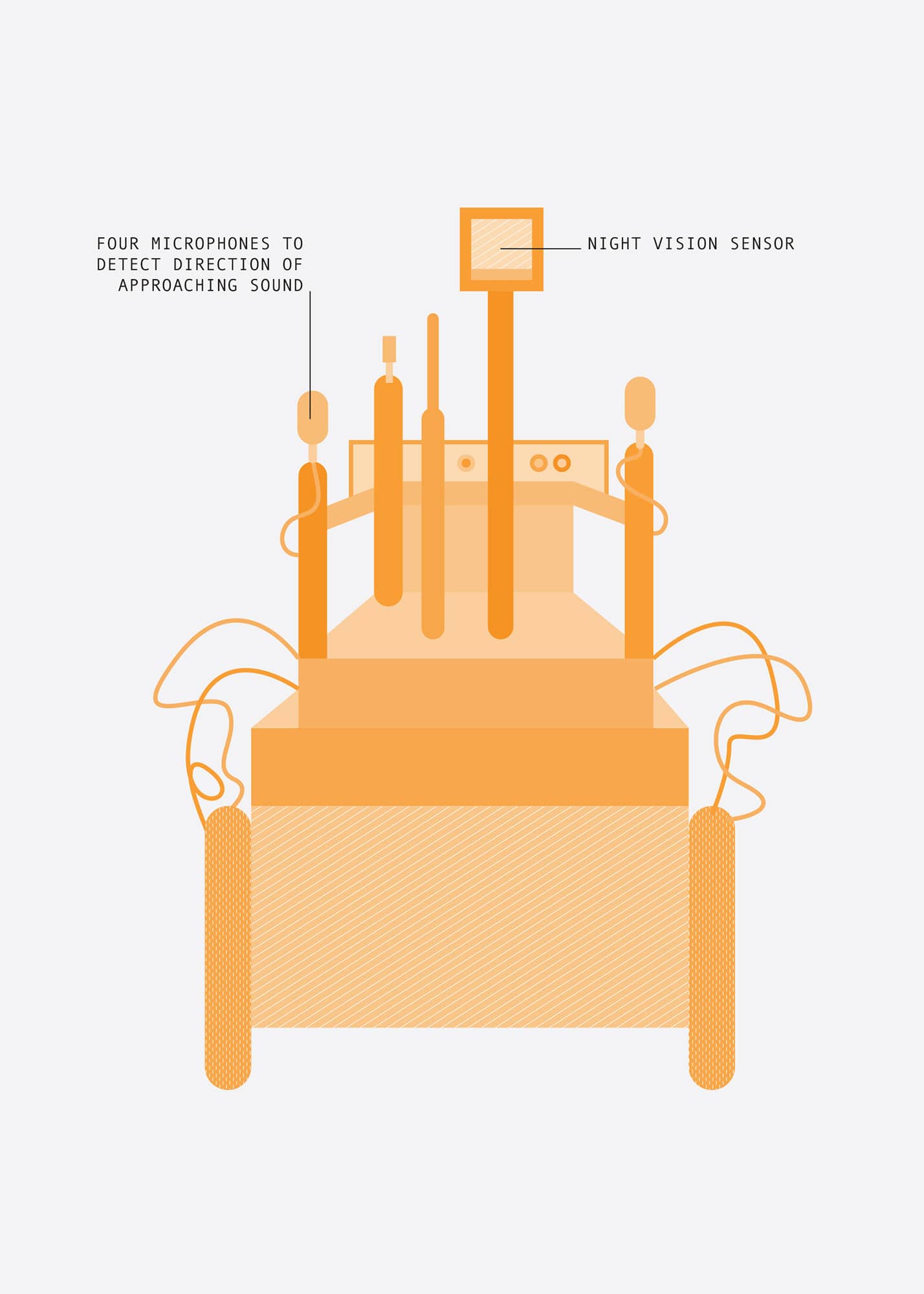
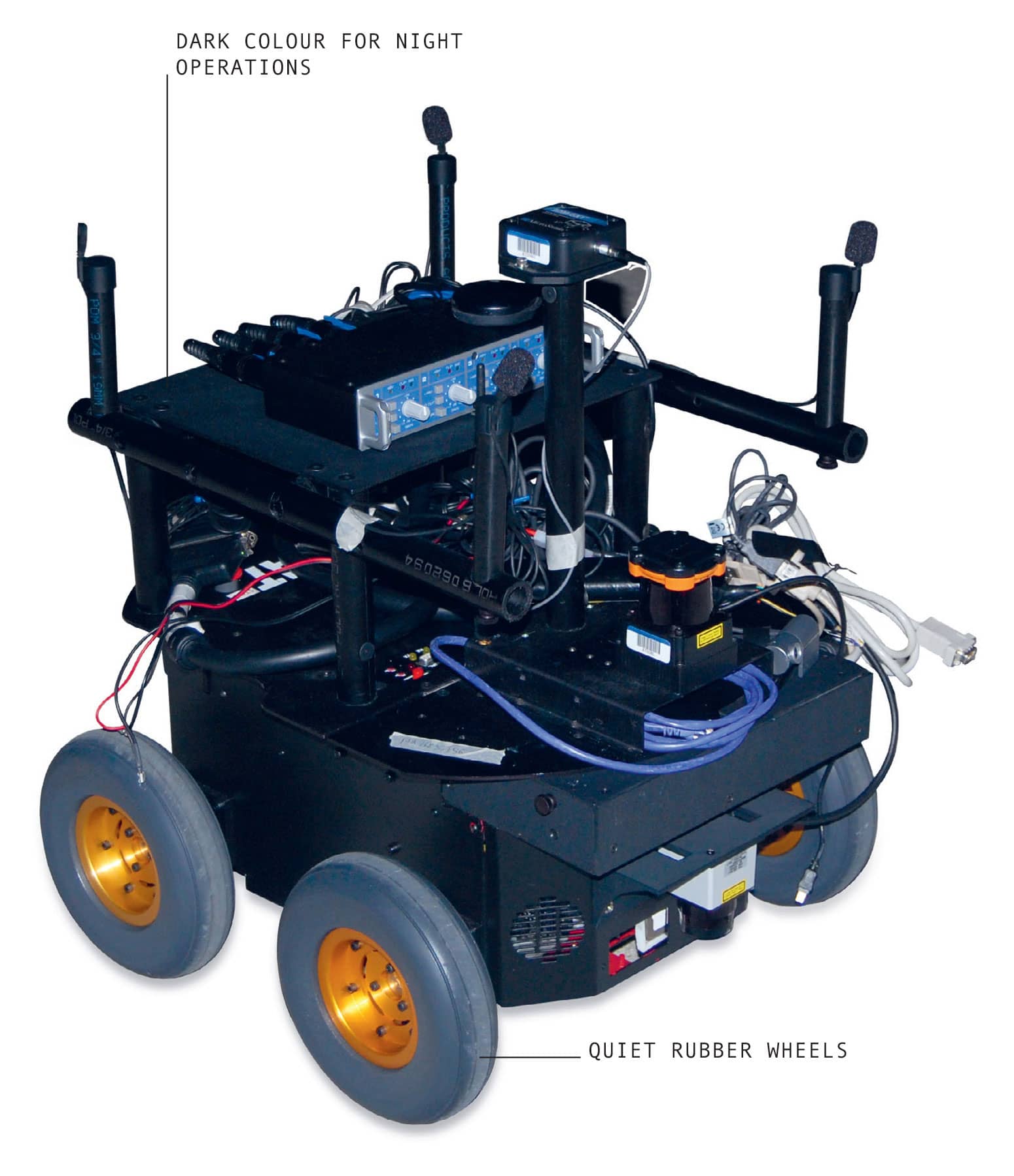
GRUMMAN X-47B
Height |
3.1m (10.1ft) |
Weight |
6.25mt (6.9lb), approx. |
Year |
2011 |
Construction material |
Composite |
Main processor |
Commercial Processors |
Power source |
Pratt & Whitney F100-220U turbofan |
In the opening stages of a conflict, one of the first priorities is to take out surface–to-air missile capacility so that attack aircraft can get through to hit targets. It is also one of the toughest challenges. This process of ‘suppression of enemy air defences’ is as dangerous as you might expect: planes have to fly right through missile defences ready and waiting to destroy aircraft.
It looks like a good job for a robot. Picking targets is relatively easy; radar sites and missile installations do not require any great discrimination by the pilot and there is little risk of hitting civilian buildings by mistake. Northrop Grumman’s X-47B, a sleek jet that resembles a scaled-down strike aircraft with no cockpit, is an unmanned model designed for just this task. It has an angular profile and looks similar to manned F-22 and F-35 fighter jets; like them, it is fast and stealthy. It is difficult to spot on radar. First, its shape prevents radar waves being reflected to their source and, second, it is coated in special radar-absorbing materials. Such stealth does not make the aircraft invisible to radar, but allows it to slip past defences without being spotted until it is too late.
The X-47B tears through the sky at up to 12,000m (40,000ft) and travelling at 600mph (965kmh). It can find its target on its own, but a human operator provides mission instructions and clearance to release weapons. Those weapons comprise over 2,000kg (4,400lb) of smart bombs and missiles stored in an internal weapons bay – anything on the wings would spoil the stealthy curves.
The X-47B was developed for the US Navy, and must operate from an aircraft carrier, hence its foldable wings for easy storage. Flight tests were carried out in 2014–15 on the USS Theodore Roosevelt. Operations from the flight deck of a carrier are very different to those on an airfield: a steam catapult launches an aircraft into the air at takeoff; when landing, the plane must do so on a moving surface that is rocking from side to side. The high tempo of many carrier operations sees drones landing and taking off at the same time as manned aircraft, so they have to share airspace safely.
The X-47B passed its carrier trials with flying colours, but there are political problems. The US Navy’s top priority, its F-35 and F-18 manned aircraft, gain all available funding. Anything that competes with them is likely to be in trouble. The programme has changed name and purpose several times since its inception in 2000. What started as an unmanned strike aircraft with some reconnaissance capability, became a reconnaissance aircraft with some strike capability that could also act as a tanker. In 2016 the requirement was further downgraded to a flying tanker with some secondary strike capability. For the time being, the drone will circle over a carrier and act as a flying petrol station for the F-35s and F-18s, which will continue to do the real work.
The latest change in role also saw the requirement for stealth being dropped. This will reduce costs, but also reduce the chances of the aircraft’s use in combat missions against defended targets. And the production design will be something slower and cheaper than the original X-47B aircraft.
The US Navy argues that having a drone tanker will give them experience of working with unmanned aircraft on carriers, and that at some future time another generation of drones might play a more important role. When that will be is rather vague, and that is proof enough that Top Guns are not ready to give up their pilot seats to machines just yet.
